双生素数对 N生素数对及哥德巴赫猜想论文
- 格式:doc
- 大小:31.50 KB
- 文档页数:12
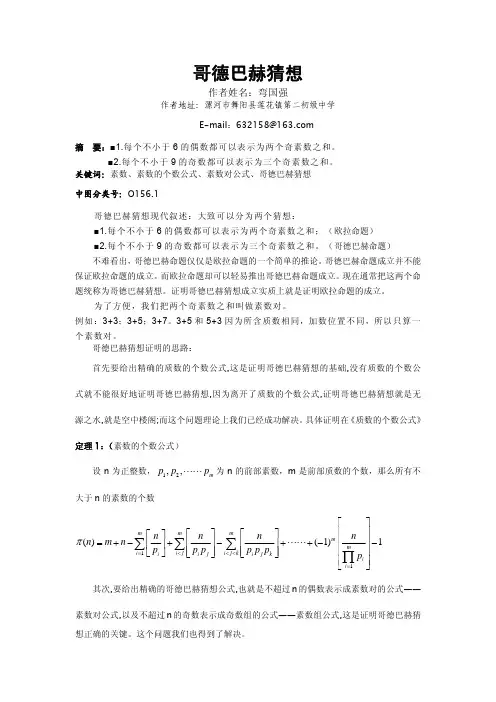
哥德巴赫猜想作者姓名:弯国强作者地址:漯河市舞阳县莲花镇第二初级中学E-mail :**************摘 要:■1.每个不小于6的偶数都可以表示为两个奇素数之和。
■2.每个不小于9的奇数都可以表示为三个奇素数之和。
关键词:素数、素数的个数公式、素数对公式、哥德巴赫猜想 中图分类号:O156.1哥德巴赫猜想现代叙述:大致可以分为两个猜想:■1.每个不小于6的偶数都可以表示为两个奇素数之和;(欧拉命题)■2.每个不小于9的奇数都可以表示为三个奇素数之和。
(哥德巴赫命题) 不难看出,哥德巴赫命题仅仅是欧拉命题的一个简单的推论。
哥德巴赫命题成立并不能保证欧拉命题的成立。
而欧拉命题却可以轻易推出哥德巴赫命题成立。
现在通常把这两个命题统称为哥德巴赫猜想。
证明哥德巴赫猜想成立实质上就是证明欧拉命题的成立。
为了方便,我们把两个奇素数之和叫做素数对。
例如:3+3;3+5;3+7。
3+5和5+3因为所含质数相同,加数位置不同,所以只算一个素数对。
哥德巴赫猜想证明的思路:首先要给出精确的质数的个数公式,这是证明哥德巴赫猜想的基础,没有质数的个数公式就不能很好地证明哥德巴赫猜想,因为离开了质数的个数公式,证明哥德巴赫猜想就是无源之水,就是空中楼阁;而这个问题理论上我们已经成功解决。
具体证明在《质数的个数公式》 定理1:(素数的个数公式)设n 为正整数,12,,m p p p ""为n 的前部素数,m 是前部质数的个数,那么所有不大于n 的素数的个数11()(1)1m m m mmi i j i j k i i j i j k i i n n n n n m n p p p p p p p π=<<<=⎡⎤⎢⎥⎡⎤⎡⎤⎡⎤⎢⎥=+−+−++−−⎢⎥⎢⎥⎢⎥⎢⎥⎢⎥⎢⎥⎣⎦⎣⎦⎣⎦⎢⎥⎣⎦∑∑∑∏"" 其次,要给出精确的哥德巴赫猜想公式,也就是不超过n 的偶数表示成素数对的公式——素数对公式,以及不超过n 的奇数表示成奇数组的公式——素数组公式,这是证明哥德巴赫猜想正确的关键。
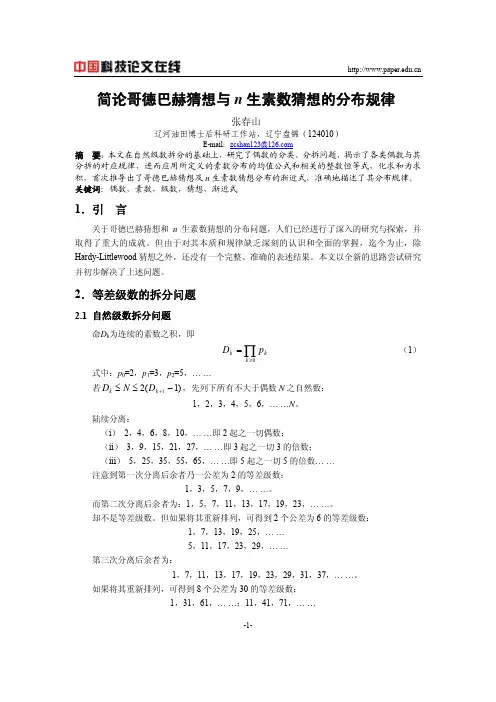

孪生素数与哥德巴赫猜想的证明Twin prime number and the Goldbach conjecture certificateJiao Hongbin【】Be to apply the vegetable that the author plain establishes to differentiate between law mainly in culture, elementary coming to give a twin out a prime number certificate and Goldbach conjecture correctness having boundless multiple-twin proves that.在本文的论述过程中,除特别规定外,需作出的某些说明,以约定示之。
约定1:本文中所说的数(包括奇根与偶根)都是正整数;素数即质数;奇素数与奇合数都简称为素数与合数;数列是指无重复数的递增无穷正整数列;非负整数集记作N;正整数集记作N+;[X]表示不超过实数X的最大整数;a、b、m、n、u、au∈N+。
引言等差数列(A):3,5,7,…,其通项公式可写为an=1+2n。
研究数列(A),创立一种新的素数判定方法,给出孪生素数有无限多对的证明以及哥德巴赫猜想正确性的初等证明,就是本文的主要目的和任务。
本文的主要结果是数学四定理;1.定理1.6;2.定理2.3;3.定理3.13与3.14。
现论述如下:1 定理1.6的证明定义1.1 设数列(A)中的任一个奇数N=1+2n,则n=12(N-1)叫做奇数N的根,或简称为奇根。
记作奇根n或在十分明确的情况下就记作n。
由奇根n确定的奇数N也记作N(n)。
当N是素数时,n叫做素数N的根,或简称为素根。
记作素根n;当N是合数时,n叫做合数N的根,或简称为合根。
记作合根n。
全体奇根组成的数列:1,2,3,…叫做奇根列。
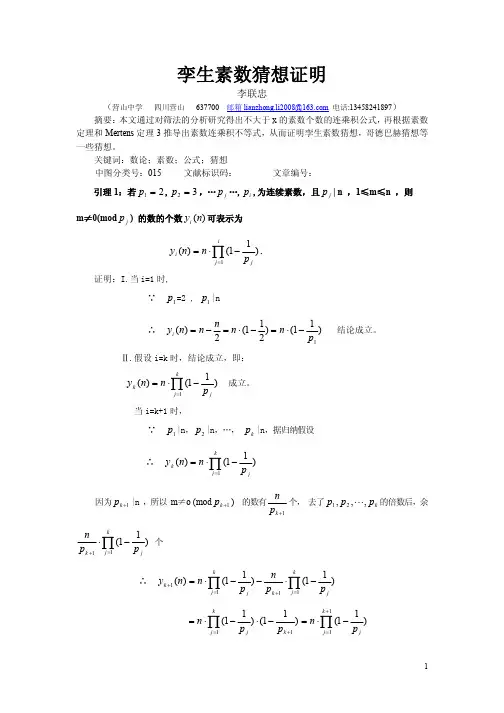
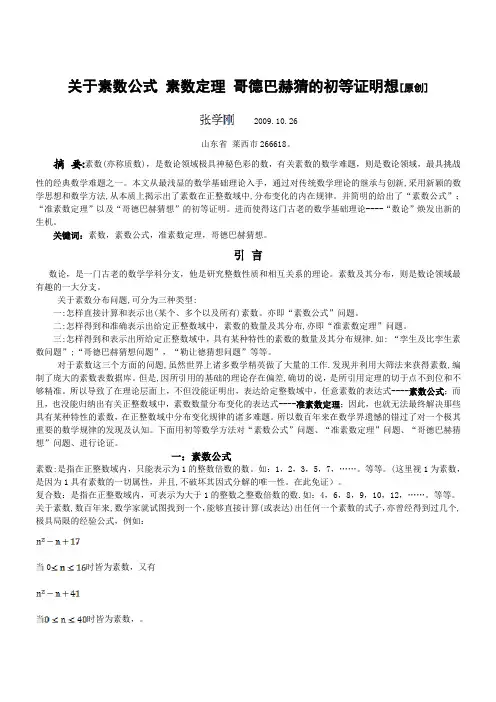
关于素数公式素数定理哥德巴赫猜的初等证明想[原创]2009.10.26山东省莱西市266618。
摘要:素数(亦称质数),是数论领域极具神秘色彩的数,有关素数的数学难题,则是数论领域,最具挑战性的经典数学难题之一。
本文从最浅显的数学基础理论入手,通过对传统数学理论的继承与创新,采用新颖的数学思想和数学方法,从本质上揭示出了素数在正整数域中,分布变化的内在规律。
并简明的给出了“素数公式”;“准素数定理”以及“哥德巴赫猜想”的初等证明。
进而使得这门古老的数学基础理论----“数论”焕发出新的生机。
关键词:素数,素数公式,准素数定理,哥德巴赫猜想。
引言数论,是一门古老的数学学科分支,他是研究整数性质和相互关系的理论。
素数及其分布,则是数论领域最有趣的一大分支。
关于素数分布问题,可分为三种类型:一:怎样直接计算和表示出(某个、多个以及所有)素数。
亦即“素数公式”问题。
二:怎样得到和准确表示出给定正整数域中,素数的数量及其分布,亦即“准素数定理”问题。
三:怎样得到和表示出所给定正整数域中,具有某种特性的素数的数量及其分布规律.如: “孪生及比孪生素数问题”;“哥德巴赫猜想问题”,“勒让德猜想问题”等等。
对于素数这三个方面的问题,虽然世界上诸多数学精英做了大量的工作.发现并利用大筛法来获得素数,编制了庞大的素数表数据库。
但是,因所引用的基础的理论存在偏差,确切的说,是所引用定理的切于点不到位和不够精准。
所以导致了在理论层面上,不但没能证明出,表达给定整数域中,任意素数的表达式----素数公式;而且,也没能归纳出有关正整数域中,素数数量分布变化的表达式----准素数定理;因此,也就无法最终解决那些具有某种特性的素数,在正整数域中分布变化规律的诸多难题。
所以数百年来在数学界遗憾的错过了对一个极其重要的数学规律的发现及认知。
下面用初等数学方法对“素数公式”问题、“准素数定理”问题、“哥德巴赫猜想”问题、进行论证。
一:素数公式素数:是指在正整数域内,只能表示为1的整数倍数的数。
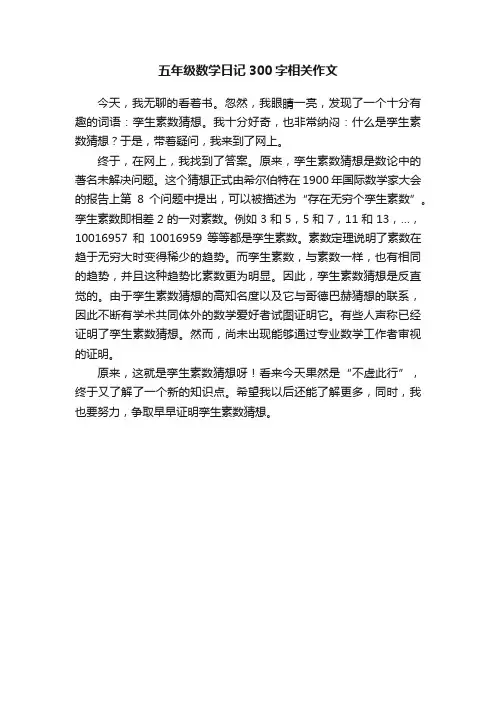
五年级数学日记300字相关作文
今天,我无聊的看着书。
忽然,我眼睛一亮,发现了一个十分有趣的词语:孪生素数猜想。
我十分好奇,也非常纳闷:什么是孪生素数猜想?于是,带着疑问,我来到了网上。
终于,在网上,我找到了答案。
原来,孪生素数猜想是数论中的著名未解决问题。
这个猜想正式由希尔伯特在1900年国际数学家大会的报告上第8个问题中提出,可以被描述为“存在无穷个孪生素数”。
孪生素数即相差2的一对素数。
例如3和5,5和7,11和13,…,10016957和10016959等等都是孪生素数。
素数定理说明了素数在趋于无穷大时变得稀少的趋势。
而孪生素数,与素数一样,也有相同的趋势,并且这种趋势比素数更为明显。
因此,孪生素数猜想是反直觉的。
由于孪生素数猜想的高知名度以及它与哥德巴赫猜想的联系,因此不断有学术共同体外的数学爱好者试图证明它。
有些人声称已经证明了孪生素数猜想。
然而,尚未出现能够通过专业数学工作者审视的证明。
原来,这就是孪生素数猜想呀!看来今天果然是“不虚此行”,终于又了解了一个新的知识点。
希望我以后还能了解更多,同时,我也要努力,争取早早证明孪生素数猜想。
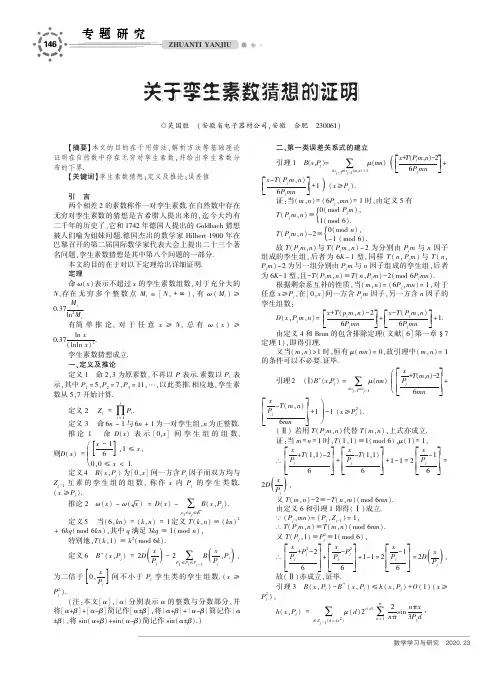
关于孪生素数猜想的证明关于孪生素数猜想的证明Һ吴国胜㊀(安徽省电子器材公司,安徽㊀合肥㊀230061)㊀㊀ʌ摘要ɔ本文的目的在于用筛法㊁解析方法等基础理论证明在自然数中存在无穷对孪生素数,并给出孪生素数分布的下界.ʌ关键词ɔ孪生素数猜想;定义及推论;误差值引㊀言两个相差2的素数称作一对孪生素数.在自然数中存在无穷对孪生素数的猜想是古希腊人提出来的,迄今大约有二千年的历史了,它和1742年德国人提出的Goldbach猜想被人们喻为姐妹问题.德国杰出的数学家Hilbert1900年在巴黎召开的第二届国际数学家代表大会上提出二十三个著名问题,孪生素数猜想是其中第八个问题的一部分.本文的目的在于对以下定理给出详细证明.定理命ω(x)表示不超过x的孪生素数组数,对于充分大的N,存在无穷多个整数点Miɪ[N,+ɕ),有ω(Mi)ȡ0.37Miln2Mi.有简单推论,对于任意xȡN,总有ω(x)ȡ0.37lnx(lnlnx)2.孪生素数猜想成立.一㊁定义及推论定义1㊀命2,3为原素数,不再以P表示.素数以Pi表示,其中P1=5,P2=7,P3=11, ,以此类推.相应地,孪生素数从5,7开始计算.定义2㊀Zj=ᵑji=1Pi.定义3㊀命6n-1与6n+1为一对孪生组,n为正整数.推论1㊀命D(x)表示[0,x]间孪生组的组数,则D(x)=x-16[],1ɤx,0,0ɤx<1.æèçç定义4㊀B(x,Pj)为[0,x]间一方含Pj因子而双方均与Zj-1互素的孪生组的组数,称作x内Pj的孪生类数.(xȡPj).推论2㊀ω(x)-ω(x)=D(x)-ðp1ɤpjɤxB(x,Pj).定义5㊀当(6,kn)=(k,n)=1定义T(k,n)ʉ(kn)2+6kq(mod6kn),其中q满足3kqʉ1(modn),特别地,T(k,1)ʉk2(mod6k).定义6㊀B∗(x,Pj)=2DxPj()-2ðP1ɤPiɤPj-1BxPj,Pi(),为二倍于0,xPj[]间不小于Pj孪生类的孪生组数.(xȡP2j).(注:本文[α],{α}分别表示α的整数与分数部分,并将[α+β]+[α-β]简记作[αʃβ],将{α+β}+{α-β}简记作{αʃβ},将sin(α+β)+sin(α-β)简记作sin(αʃβ).)二㊁第一类误差关系式的建立引理1㊀B(x,Pj)=ðn|zj-1m|zj-1(m,n)=1μ(mn)(x+T(Pjm,n)-26Pjmnéëêùûú+x-T(Pjm,n)6Pjmnéëêùûú+1)(xȡPj).证:当(m,n)=(6Pj,mn)=1时,由定义5有T(Pjm,n)ʉ0(modPjm),1(mod6).{T(Pjm,n)-2ʉ0(modn),-1(mod6).{故T(Pjm,n)与T(Pjm,n)-2为分别由Pjm与n因子组成的孪生组,后者为6K-1型,同样T(n,Pjm)与T(n,Pjm)-2为另一组分别由Pjm与n因子组成的孪生组,后者为6K-1型,且-T(Pjm,n)ʉT(n,Pjm)-2(mod6Pjmn).根据剩余系互补的性质,当(m,n)=(6Pj,mn)=1,对于任意xȡPj,在[0,x]间一方含Pjm因子,另一方含n因子的孪生组数:D(x,Pjm,n)=x+T(pjm,n)-26Pjmnéëêùûú+x-T(Pjm,n)6Pjmnéëêùûú+1.由定义4和Brun的包含排除定理(文献[6]第一章ɦ7定理1),即得引理.又当(m,n)>1时,恒有μ(mn)=0,故引理中(m,n)=1的条件可以不必要.证毕.引理2㊀(Ⅰ)B∗(x,Pj)=ðn|zj-1m|zj-1μ(mn)æèççxPj+T(m,n)-26mnéëêêêùûúúú+xPj-T(m,n)6mnéëêêêùûúúú+1öø÷÷-1(xȡP2j).(Ⅱ)若用T(Pjm,n)代替T(m,n),上式亦成立.证:当m=n=1时,T(1,1)ʉ1(mod6),μ(1)=1,ʑxPj+T(1,1)-26éëêêêùûúúú+xPj-T(1,1)6éëêêêùûúúú+1-1=2xPj-16éëêêêùûúúú=2DxPj(),又T(m,n)-2ʉ-T(n,m)(mod6mn).由定义6和引理1即得(Ⅰ)成立.ȵ(Pj,mn)=(Pj,Zj-1)=1,ʑT(Pjm,n)ʉT(m,n)(mod6mn).又T(Pj,1)ʉP2jʉ1(mod6),ʑxPj+P2j-26éëêêêùûúúú+xPj-P2j6éëêêêùûúúú+1-1=2xPj-16éëêêêùûúúú=2DxPj(),故(Ⅱ)亦成立,证毕.引理3㊀B(x,Pj)-B∗(x,Pj)ɤh(x,Pj)+O(1)(xȡP2j),h(x,Pj)=ðd|Zj-1(d<4x2)μ(d)2v(d)ðɕn=12nπsinnπx3Pjd㊃cosnπT(Kξ)3Pjd-cosnπT(Kξ)3dæèçöø÷,其中T(Kξ)=TPjKξ,Zj-1Kξæèçöø÷,Kξ为Ki|Zj-1之某一值,v(d)表示d的不同素因子的个数,v(1)=0.证:命φ表示Ki|Zj-1的集合,因Zj-1无重复素因子,故对于任一Zj-1,Ki之集合有且仅有ðj-1k=1Ckj-1=2j-1个元素组成,当(l1,l2)=(l1,6Pjmn)=(l2,6Pjmn)=1,有T(l1Pjm,l2n)ʉT(Pjm,n)(mod6Pjmn).由引理1,2即可得到:B(x,Pj)-B∗(x,Pj)=ðKi|Zj-112j-1ðd|Zj-1μ(d)2v(d)㊃æèççx+T(Ki)-26Pjdéëêùûú+x-T(Ki)6Pjdéëêùûú-xPj+T(Ki)-26déëêêêùûúúú-xPj-T(Ki)6déëêêêùûúúúöø÷÷+1,(1)现估计(1)式中第一㊁三两项中消去-2后所产生的误差R=R1+R3,命Ai=x+T(Ki)有:Ai-26Pjdéëêùûú=[Ai]-26Pjdéëêùûú=Ai6Pjdéëêùûú-1,当[Ai]ʉ0或1(mod6Pjd),Ai6Pjdéëêùûú,其他.ìîíïïïï故知只有当[Ai]=6PjMiDi+δ(δ=0或1,其中Di|Zj-1)时才产生误差,根据同余的性质有:ðd|Diμ(d)2v(d)=1,v(Di)为偶数或0,-1,v(Di)为奇数,{ʑR1ɤ12j-1ðKi|Zj-11=1,同样可证得|R3|ɤ1.ʑ|R|ɤ|R1|+|R3|ɤ2,故由(1)式知必定存在某一Kξ|Zj-1,使得:B(x,Pj)-B∗(x,Pj)ɤh(x,Pj)+O(1),其中h(x,Pj)=ðd|Zj-1μ(d)2v(d)æèççxʃT(kξ)6Pjdéëêùûú-xPjʃT(Kξ)6déëêêêùûúúúöø÷÷,ȵPjKξ|T(Kξ),Zj-1Kξ|T(Kξ)-2,(注:以下将T(Kξ)简记作T)ʑd|Zj-1|T(T-2).因d无重复素因子,故知对于任意d,当dȡ4x2可分解为d=d1d2,其中d2ȡd1ȡ1,使d2|T或者d2|(T-2)两者之一成立.显然d2ȡ2x>x+2Pj(xȡP2j),如d2|T成立,有0<xd2=β<1,Td2=L,显然(6,L)=1,因而-L6q[]=-1-L6q[](q为正整数),故有:xʃT6Pjd[]-xPjʃT6déëêêêùûúúú=βʃL6Pjd1[]-βʃPjL6Pjd1éëêùûú=ʃL6Pjd1[]-ʃL6d1[]=0,同样如d2|(T-2),则有0<x+2d2=β1<1,0<x-2d2=β2<1,0<x+2Pjd2=β3<1,0<x-2Pjd2=β4<1,T-2d2=L,则(6,L)=1,即有xʃT6Pjd[]-xPjʃT6déëêêêùûúúú=β1+L6Pjd1éëêùûú+β2-L6Pjd1éëêùûú-β3+PjL6Pjd1éëêùûú-β4-PjL6Pjd1éëêùûú=ʃL6Pjd1[]-ʃL6d1[]=0,ʑh(x,Pj)=ðd|Zj-1(d<4x2)μ(d)2v(d)xʃT6Pjd[]-xʃPjT6Pjdéëêùûúæèçöø÷=ðd|Zj-1(d<4x2)μ(d)2v(d)xʃPjT6Pjd{}-xʃT6Pjd{}æèçöø÷,(2)由Fourier展开式,当{α}ʂ0时有:{α}=-ðɕn=11nπsin(2nπα)+12,(3)ȵPj|T,ʑ只需取x,当Pj|x,即有(2)式中任意一项{αi}ʂ0均适用于(3)式,故(2)式又可表示为:h(x,Pj)=ðd|Zj-1(d<4x2)μ(d)2v(d)ðɕn=12nπsinnπx3Pjd(cosnπT3Pjd-cosnπT3d),证毕.三、第一类误差值的计算引理4㊀用M[F1(y)]表示函数F1(y)的Mellin变换式,若有M[F1(y)]=ðd|Zj-1(d<4x2)μ(d)2v(d)ds-2(ζ(2-s)-1)(s-1),取σ=ReS=1-1lny,当y>Pj时,必有|F1(y)|=Oln2Pjylnyæèçöø÷.证:σ=1-1lny>1-1lnPj>0.首先证明M[F1(y)]绝对收敛.令H(s)=ðd|Zj-1(d<4x2)μ(d)2v(d)ds-2,(4)则H(s)ɤðd|Zj-2|μ(d)|2v(d)|ds-2|=ᵑP|Zj-1(1+2Pσ-2),ʑln|H(s)|ɤlnᵑP|Zj-1(1+2Pσ-2)=ðP1ɤPɤPj-1ln(1+2P-1-1lny)ɤðP1ɤPɤPj-12P-1=2lnlnPj+O(1).(参见文献[2]第七章ɦ3Mertens公式)ʑ|H(s)|=Ο(ln2Pj)绝对收敛.又Re(2-s)=1+1lny>1,令b1(u)={u}-12,有ζ(2-s)=11-s+12-(2-s)ʏɕ1b1(u)u3-sdu=-1s-1+1+ʏɕ1{u}dus-2,(参考文献[1]第八章ɦ2)ʏɕ1{u}dus-2为{u}ʂ0时的瑕积分,记作P㊃V.P㊃Vʏɕ1{u}dus-2={u}us-2ɕ1-P㊃Vʏɕ1us-2d{u}=-P㊃Vʏɕ1us-2d{u}dudu,当{u}ʂ0,由(3)式有d{u}du=-2ðɕn=1cos(2nπu)=-limλңɕsinλ+12()2πusinπu+1,(参考文献[7](3.6.1)式)综上即得:Q=(ζ(2-s)-1)(s-1)=-1+(s-1)P㊃Vʏɕ1us-2limλңɕsinλ+12()2πusinπu-1æèççöø÷÷du=-1+P㊃Vʏɕ1(limλңɕsinλ+12()2πusinπu-1)dus-1=P㊃Vʏɕ1limλңɕsinλ+12()2πusinπudus-1,ʑ|Q|ɤP㊃Vʏɕ1|limλңɕsinλ+12()2πusinπu|㊃|dus-1|=|limλңɕsinλ+12()2πξsinπξ|ʏɕ1du-1lny|ɤ1sinπξ<+ɕ({ξ}ʂ0),ʑM[F1(y)]绝对收敛.令ʏ(σ)=limAңɕʏσ+iAσ-iA,由文献[1]第十二章ɦ1引理1有:F1(y)=12πiʏ(σ)M[F1(y)]y-sds=12πiʏ(σ)H(s)(ζ(2-s)-1)(s-1)y-sds=-12πiʏ(σ)H(s)(ζ(2-s)-1)dy-s+1dyds=i2πʏ(σ)H(s)(ζ(2-s)-1)dsdydy-s+1.ȵζ(2-s)-1=ðɕn=21n2-s,ʑ|ζ(2-s)-1|ɤðɕn=21n1+1lny=ʏɕ1duu1+1lny+O(1)=-lny㊃u-1lnyɕ1+O(1)=lny+O(1),dsdy=d1lnydy=1yln2y,|yit|=|eitlny|=1,y-σ+1=y1lny=e.当y>Pj,lny>lnPj≫1,ʑ|F1(y)|ɤʏ(σ)|H(s)||ζ(2-s)-1|dsdy|dy-s+1|ɤʏ(σ)O(ln2Pj)(lny+O(1))1yln2ydy1lny=Oln2Pjylnyæèçöø÷,证毕.引理5㊀对于充分大的x,恒有B(x,Pj)-B∗(x,Pj)ɤOxln3PjP2jæèçöø÷+O(1),当Pjɤx12时,误差项O(1)可以不计.证:(Ⅰ)当Pjɤ6lnx时,ȵðɕn=12nπsinnπαcosnπβɤ1,又v(P)=1,由引理3有:h(x,Pj)ɤ2ðd|Zj-1|μ(d)|2v(d)=2ᵑP|Zj-1(1+2v(P))=2㊃3j-1.由素数定理得j=π(Pj)=PjlnPj1+O1lnPj()().ʑB(x,Pj)-B∗(x,Pj)ɤ2㊃3j-1+O(1)<3jɤ37lnxlnlnx=x7ln3lnlnx<x12≪xln3PjP2j.(Ⅱ)当x12<Pjɤx,显然有B(x,Pj)-B∗(x,Pj)=B(x,Pj)=1,Pj与Pj+2为孪生素数,0,其他.{(Ⅲ)现着重讨论6lnx<Pjɤx12的情形.由引理3我们有:㊀h(x,Pj)=ðd|Zj-1(d<4x2)μ(d)2v(d)ðɕn=14nπ㊃nπd㊃sinnπx3PjdʏT6T6Pjsin2nπqddq=ʏT6T6Pjðd|Zj-1(d<4x2)μ(d)2v(d)ðɕn=12d(cosq-x6Pjd2nπ-cosq+x6Pjd2nπ)dq=ʏT6T6Pjʏq+x6Pjq-x6Pj(ðd|Zj-1(d<4x2)μ(d)2v(d)ðɕn=14nπd2sin2nπdy)dydq=ʏT6T6Pjʏq+x6Pjq-x6PjF(y)dydq.由积分不等式,当b>aȡ0时,若在区间[a,b]上f(x),g(x)可积,|f(x)|ɤ|g(x)|,则有ʏbaf(x)dxɤʏba|f(x)|dxɤʏba|g(x)|dx.又F(y)可积,则有:h(x,Pj)ɤʏT6T6Pjʏq+x6Pjq-x6PjF(y)dydq,(5)F(y)是实连续函数,y>0(见(9)式),我们可对其取Mellin变换,令ReS=1-1lny,当α>0时,M[sinαx]=ʏɕ0sinαx㊃xs-1dx=α-sΓ(s)sinπs2,ʑM[F(y)]=ðd|Zj-1(d<4x2)μ(d)2v(d)ðɕn=1(nπ)1-s22-sΓ(s)ds-2sinπs2,(6)ðɕn=1n1-s=ζ(s-1),Γ(s)=(s-1)Γ(s-1)(文献[5]第二章ɦ2定理2),sinπs2=cosπ(s-1)2.根据RiemannZeta函数解析开拓的性质(文献[3]第二篇第二章ɦ2定理2.1)有ζ(1-s)=21-sπ-scosπs2Γ(s)ζ(s)普遍成立.ʑ由(6)式和(4)式有:M[F(y)]=ζ(s-1)Γ(s-1)(s-1)π1-s22-sH(s)㊃cosπ(s-1)2=ζ(2-s)(s-1)H(s),令F(y)=F1(y)+F2(y),则M[F(y)]=M[F1(y)]+M[F2(y)],其中M[F1(y)]=(ζ(2-s)-1)(s-1)H(s),(7)M[F2(y)]=(s-1)H(s),相应地,h(x,Pj)=h1(x,Pj)+h2(x,Pj),首先证明h2(x,Pj)=0.ȵPjKξT,Zj-1Kξ(T-2)(见引理3),ʑTȡPjKξ,T-2ȡZj-1Kξ,T2>T(T-2)ȡPjKξ㊃Zj-1Kξ=PjZj-1=Zj,T>Zj(注:当xȡP2j,必有d通过所有PɤPj-1,故(5)式中T不变.)由文献[1]第三章ɦ1定理2契贝谢夫θ函数性质有:lnT>12lnZj>12-ε()Pjȡ12-ε()6lnx>2.8lnx,即有1lnT=O1Pj(),(8)及T>x2.8,又xȡP2j,由(5)式知yȡq-x6PjȡT-x6Pj>x2.8-x6x≫x2.2≫4x2,(9)h2(x,Pj)=ʏT6T6Pjʏq+x6Pjq-x6PjF2(y)dydq=(ʏɕT-x6Pj-ʏɕT-xPj6-ʏɕT+x6Pj+ʏɕT+xPj6)ʏɕφF2(η)dηdφ,由Mellin变换公式(文献[8]581页),若M[f(y)]=M(s),则有:M[ʏɕyf(φ)dφ]=M(s+1)s成立,由此推出:M[ʏɕyʏɕφf(η)dηdφ]=M(s+2)(s+1)s成立.令U(y)=ʏɕyʏɕφF2(η)dηdφ,由M[F2(y)]=(s-1)H(s)得到M[U(y)]=(s+2-1)H(s+2)(s+1)s=1sH(s+2),由(9)式y≫4x2,即σ=1-1lny>0,因而|M[U(y)]|=1σ+itH(2+σ+it)ɤðd|Zj-1|μ(d)|2v(d)dσ1σ+it=1σ2+t2ðd|Zj-1|μ(d)|2v(d)dσ<+ɕ绝对收敛.即有:U(y)=12πiʏσ+iɕσ-iɕM[U(y)]y-sds=12πiʏσ+iɕσ-iɕðd|Zj-1(d<4x2)μ(d)2v(d)1sdy()sds,根据Mellin变换表(文献[8]582页)有12πiʏσ+iɕσ-iɕ1sαy()sds=1(y<α),0(y>α),{(σ>0)由(9)式得y>4x2>d,ʑU(y)=0,即可得到h2(x,Pj)的各项积分均为0,ʑh2(x,Pj)=0.又F1(y)满足引理4的条件,由(5)式有:h(x,Pj)=h1(x,Pj)ɤOʏT6T6Pjʏq+x6Pjq-x6Pjln2Pjylnydydqæèçöø÷=Oln2PjʏT6T6Pjlnlnq+x6Pj()lnq-x6Pj()dqæèçççöø÷÷÷=Oxln2PjPjʏT6T6Pjdqqlnqæèçöø÷=Oxln2PjPjlnlnT6lnT6Pjæèçççöø÷÷÷=Oxln3PjPjlnTæèçöø÷=Oxln3PjP2jæèçöø÷.注1:上式中,lnlnq+x6Pj()lnq-x6Pj()=lnlnq+ln1+x6qPj()lnq+ln1-x6qPj()=Oln1+1lnqln1+x6qPj()()()=O1lnqln1+x6qPj()()=O1lnq㊃x6qPj()=OxPjqlnq().注2:上式中,lnlnT6lnT6qPj=lnlnT6lnT6+ln1Pj=ln11-lnPjlnT6=Oln1+lnPjlnT6æèççöø÷÷æèççöø÷÷=OlnPjlnTæèçöø÷.最后一步用到(8)式,综上即得到引理.证毕.四㊁函数G(u)的性质引理6若G(u)满足方程G(u)=1u2,㊀㊀㊀㊀㊀㊀1ɤuɤ2,㊀㊀㊀㊀(10)(u2G(u))ᶄ=2uG(u-1),u>2,(11){则G(u)为连续函数,对于任意uȡ1,恒有14ɤG(u)ɤ1.证:令G(u)=G1(u)+G2(u),其中G1(u),G2(u)满足方程:G1(u)=1u2,G2(u)=0,㊀1ɤuɤ2,(u2G1(u))ᶄ=2uG2(u-1),(u2G2(u))ᶄ=2uG1(u-1),u>2,{解之即知G1(u),G2(u)均为连续函数,故G(u)为连续函数.由(10)式知,当1ɤuɤ2时,有14ɤG(u)ɤ1成立.用数学归纳法证明,当u>2时,也有14ɤG(u)ɤ1.由(11)式即得:u2G(u)-22G(2)=2ʏu2tG(t-1)dtɤ2ʏu2tdt=u2-22,ʑG(u)ɤ1-3u2ɤ1.又u2G(u)-22G(2)=2ʏu2tG(t-1)dtȡ12ʏu2tdt=14(u2-22)=14u2-1,ʑG(u)ȡ14.证毕.五、定理的反证1.在假设基础上得到的结果(第二类误差值的计算)引理7㊀对于充分大的N,当yȡN时,假设恒有ω(y)<Cyln2y㊀(12)成立,C=0.37,则当x12ȡPjȡlnxȡN时,恒有B(x,Pj)<2CG(u)xPjln2Pj+OxPjln3Pjæèçöø÷成立,其中Pj=x1u+1,即u=lnxlnPj-1.证:用数学归纳法证明.当N充分大,PjȡN时,有Pjȡln7Pj,故有xP2jln3PjɤxPjln4Pj.当x12ȡPjȡx13(1ɤuɤ2)时,由(12)式,引理5,定义6及推论2有:B(x,Pj)ɤB∗(x,Pj)+OxP2jln3Pjæèçöø÷=2ωxPj()-2ω(Pj-1)+OxPjln4Pjæèçöø÷<2CxPjln2xPj()+OxPjln4Pjæèçöø÷=2CxPj(lnxuu+1)2+OxPjln4Pjæèçöø÷=2Cxu2Pjln2Pj+OxPjln3Pjæèçöø÷,即知当1ɤuɤ2时,G(u)=1u2,引理成立.若x1k-1ȡPjȡx1k,kȡ3(即k-2ɤuɤk-1),引理成立,则当x1kȡPjȡx1k+1,k-1ɤuɤk时由引理5及推论2有:B(x,Pj)ɤB∗(x,Pj)+OxP2jln3Pjæèçöø÷=2ðPjɤPiɤxPj()12BxPj,Pi()+2ωxPj()-2ωxPj()12()+OxPjln4Pjæèçöø÷.此处着重说明:在以上递推计算中每项都有一个差式,如记作ω+i-ω-i,易见对于每个差式,恒有ω+iȡω-iȡω(Pj),故参加递推和式计算之ω(t)均符合引理假设的条件,即:ωxPj()ȡω(t)ȡω(Pj)ȡω(lnx)ȡω(N).又x1k+1ɤPj,ʑxɤPk+1j,即有xPj()1kɤPjɤPiɤxPj()12.因而可由已知递推得:B(x,Pi)<4CðPjɤPiɤxPj()12GlnxPjlnPi-1æèççöø÷÷xPjPiln2Pi+OðPjɤPiɤxPj()122xPjPiln3Piæèçöø÷+2CxPjln2xPj()+OxPjln4Pjæèçöø÷,(13)用Abel恒等式计算:Ω=ðPjɤPiɤxPj()12GlnxPjlnPi-1æèççöø÷÷1Piln2Pi,在文献[1]第三章ɦ1引理2中取A(t)=ðPɤtlnPP,当tȡPjȡlnx充分大时,由文献[1]第四章命题(C)式有:A(t)=ðnɤtΛ(n)n-ðmȡ2ðPɤt1mlnPPm=lnt-γ+O(1)-E(t),其中γ为Euler常数,E(t)=ðmȡ2ðPlnPPm-ðmȡ2ðP>t1mlnPPm=α1+Oʏɕtlnqq2dqæèçöø÷=α1+Olnttæèçöø÷=α1+O(1),ʑA(t)=lnt-α+O(1),ȵα1,γ均为与t无关的常数,ʑα亦为与t无关之常数.令H(t)=lnt,r(t)=-α+O(1),f(t)=GlnxPjlnt-1æèççöø÷÷1ln3t.ȵH(t)连续可微,及14ɤG(u)ɤ1,由文献[1]第三章ɦ1引理2即可得到:Ω=ʏxPj()12PjGlnxPjlnt-1æèççöø÷÷dttln3t+RxPj()12,Pj()其中RxPj()12,Pj()=rxPj()12()fxPj()12()-r(Pj)f(Pj)-ʏxPj()12Pjr(t)fᶄ(t)dt=OfxPj()12()+O(f(Pj))+OʏxPj()12Pjfᶄ(t)dt()=O1ln3Pjæèçöø÷.故由(13)式即有:B(x,Pi)<4CxPjʏxPj()12PjGlnxPjlnt-1æèççöø÷÷dttln3t+OxPjln3Pjæèçöø÷+OxPjʏxPj()12Pj2tln4tæèçöø÷dt+2CxPjln2xPj()+OxPjln4Pjæèçöø÷=4CxPjln2xPj()ʏxu2(u+1)x1u+1GlnxPjlnt-1æèççöø÷÷㊃lnxPjlntæèççöø÷÷3dlntlnxPjæèççöø÷÷+OxPjln3Pjæèçöø÷+OxPjʏ12lnxPjlnPj2τ4dτæèçöø÷+2Cxu2Pjln2Pj+OxPjln4Piæèçöø÷=2Cxu2Pjln2Pjʏu22βG(β-1)dβ+O2x3Pjln3Pjæèçöø÷+OxPjln3Pjæèçöø÷+2Cxu2Pjln2Pj=2Cxu2Pjln2Pj[β2G(β)]u2+OxPjln3Pjæèçöø÷+2Cxu2Pjln2Pj=2CG(u)xPjln2Pj+OxPjln3Pjæèçöø÷,其中22G(2)=1,故引理亦成立.证毕.2.由正态分布及其误差值计算所得到的结果引理8㊀当100lnxȡPjȡlnxȡN时,有B(x,Pj)>0.75xPjln2Pj.证:由引理1即可得到:B(x,Pj)=ðm|Zj-1n|Zj-1μ(mn)2x6Pjmn+O(3j)=x3Pjðd|Zj-1μ(d)2v(d)d+O(3j)=x3PjᵑP|Zj-11-2P()+O(3j)(参见文献[3]15页)ᵑP|Zj-11-2P()=ᵑP|Zj-1(P-1)2P2ᵑP|Zj-1P(P-2)(P-1)2=ᵑP|Zj-1P-1P()2ᵑP|Zj-11-1(P-1)2æèçöø÷,由Mertens公式(文献[2]第七章ɦ3)有ᵑP|Zj-1P-1P()=3㊃(2-1)(3-1)2㊃3ᵑP|Zj-1P-1P=3e-rlnPj1+O1lnPj()(),又1>ᵑP|Zj-11-1(P-1)2æèçöø÷>ᵑP1-1(P-1)2æèçöø÷>(32-1)ᵑ(P2-1)32ᵑP2=43(22-1)(32-1)ᵑ(P2-1)22㊃32ᵑP2éëêêùûúú=43ðɕn=11n2æèçöø÷-1=43π26()-1=8π2>0.81.由素数定理,当lnx充分大时,有jɤ1.1PjlnPjɤ110lnxlnlnx<12lnx,ʑO(3j)=O(312lnx)=O(xln32)=O(x0.6).综上即得B(x,Pj)=x3Pj㊃9e-2rln2Pj1+O1lnPj()()2㊃ᵑP|Zj-11-1(P-1)2æèçöø÷+O(x0.6)>3e-2r(1-0.01)20.81xPjln2Pj+O(x0.6)>0.7507xPjln2Pj+O(x0.6)>0.75xPjln2Pj,证毕.三㊁结㊀论当100lnxȡPjȡlnxȡN时,由引理7又有:B(x,Pj)<2CG(u)xPjln2Pj+OxPjln3Pjæèçöø÷ɤ2CxPjln2Pj+OxPjln3Pjæèçöø÷<(2C+ε)xPjln2Pj<0.75xPjln2Pj,这就与引理8的结果相矛盾,因此引理7的假设不能成立.因引理7计算中的ω(t)均为:ω(x)ȡω(t)ȡω(lnx)ȡω(N),故可推出至少存在一点ξ,xȡξȡlnx,有:ω(ξ)ȡ0.37ξln2ξ成立.故有:ω([ξ])=ω(ξ)ȡ0.37ξln2ξȡ0.37[ξ]ln2[ξ].(14)即可推出在[N,eN]之间至少有一个整数点m1使(14)式成立,同样在[m1,em1]之间至少有一个整数点m2使(14)式成立,如此等等,依次类推,就证明了定理的真实性.由上述我们立即可以得到一个简单的推论:对于任意xȡN,总有:ω(x)ȡ0.37lnx(lnlnx)2成立.孪生素数猜想得证.定理证毕.ʌ参考文献ɔ[1]潘承洞,潘承彪.素数定理的初等证明[M].上海:上海科学技术出版社,1988.[2]潘承洞,潘承彪.哥德巴赫猜想[M].北京:科学出版社,1981.[3]闵嗣鹤.数论的方法(上册)[M],北京:科学出版社,1981.[4]闵嗣鹤,严士健.初等数论(第二版)[M].北京:人民教育出版社,1982.[5][苏]A.A.卡拉楚巴著,潘承彪,张南岳译.解析数论基础(中译本)[M].北京:科学出版社,1984.[6]华罗庚.数论导引[M].北京:科学出版社,1979.[7]G.H.哈代,W.W.洛戈辛斯基著,徐瑞云,王斯雷译.富里埃级数(中译本)[M].上海:上海科学技术出版社,1978.[8]‘数学手册“编写组.数学手册[M].北京:人民教育出版社,1979.[9]潘承洞.素数分布与哥德巴赫猜想[M].济南:山东科学技术出版社,1979.。
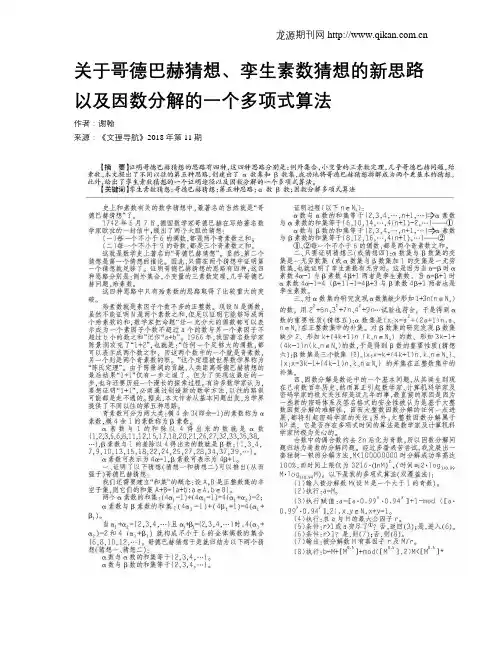
关于哥德巴赫猜想、孪生素数猜想的新思路以及因数分解的一个多项式算法作者:谢翰来源:《文理导航》2018年第11期【摘要】证明哥德巴赫猜想的思路有四种,这四种思路分别是:例外集合,小变量的三素数定理,几乎哥德巴赫问题,殆素数。
本文提出了不同以往的第五种思路,创建出了α数集和β数集,成功地将哥德巴赫猜想拆解成为两个更基本的猜想。
此外,给出了孪生素数猜想的一个证明途径以及因数分解的一个多项式算法。
【关键词】孪生素数猜想;哥德巴赫猜想;第五种思路;α数β数;因数分解多项式算法史上和素数有关的数学猜想中,最著名的当然就是“哥德巴赫猜想”了。
1742年6月7日,德国数学家哥德巴赫在写给著名数学家欧拉的一封信中,提出了两个大胆的猜想:(一)每一个不小于6的偶数,都是两个奇素数之和;(二)每一个不小于9的奇数,都是三个奇素数之和。
这就是数学史上著名的“哥德巴赫猜想”。
显然,第二个猜想是第一个猜想的推论。
因此,只需在两个猜想中证明第一个猜想就足够了。
证明哥德巴赫猜想的思路有四种,这四种思路分别是:例外集合,小变量的三素数定理,几乎哥德巴赫问题,殆素数。
这四种思路中只有殆素数的思路取得了比较重大的突破。
殆素数就是素因子个数不多的正整数。
现设N是偶数,虽然不能证明N是两个素数之和,但足以证明它能够写成两个殆素数的和,数学家把命题“任一充分大的偶数都可以表示成为一个素因子个数不超过a个的数与另一个素因子不超过b个的数之和”记作“a+b”。
1966年,我国著名数学家陈景润攻克了“1+2”,也就是:“任何一个足够大的偶数,都可以表示成两个数之和,而这两个数中的一个就是奇素数,另一个则是两个奇素数的积。
”这个定理被世界数学界称为“陈氏定理”。
由于陈景润的贡献,人类距离哥德巴赫猜想的最后结果“1+1”仅有一步之遥了。
但为了实现这最后的一步,也许还要历经一个漫长的探索过程。
有许多数学家认为,要想证明“1+1”,必须通过创造新的数学方法,以往的路很可能都是走不通的。
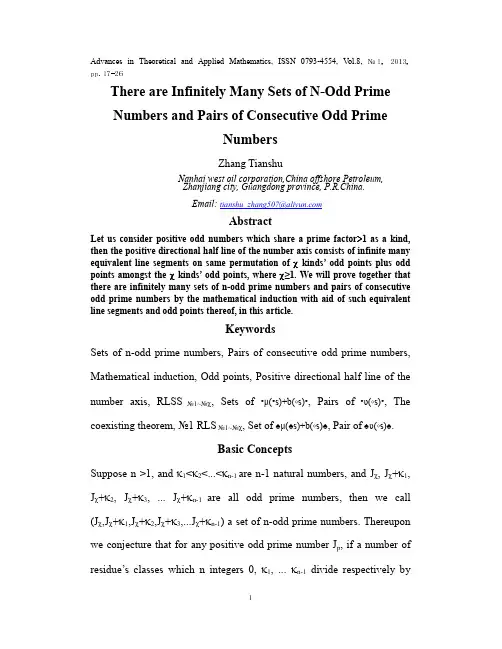
Advances in Theoretical and Applied Mathematics, ISSN 0793-4554, V ol.8,№1, 2013, pp.17-26There are Infinitely Many Sets of N-Odd PrimeNumbers and Pairs of Consecutive Odd PrimeNumbersZhang TianshuNanhai west oil corporation,China offshore Petroleum,Zhanjiang city, Guangdong province, P.R.China.Email: tianshu_zhang507@AbstractLet us consider positive odd numbers which share a prime factor>1 as a kind, then the positive directional half line of the number axis consists of infinite many equivalent line segments on same permutation of χkinds’ odd points plus odd points amongst the χkinds’ odd points, where χ≥1. We will prove together that there are infinitely many sets of n-odd prime numbers and pairs of consecutive odd prime numbers by the mathematical induction with aid of such equivalent line segments and odd points thereof, in this article.KeywordsSets of n-odd prime numbers, Pairs of consecutive odd prime numbers, Mathematical induction, Odd points, Positive directional half line of the number axis, RLSS№1~№χ, Sets of •µ(•s)+b(◦s)•, Pairs of•υ(◦s)•, The coexisting theorem, №1 RLS №1~№χ, Set of♠µ(♠s)+b(◦s)♠,Pair of♠υ(◦s)♠.Basic ConceptsSuppose n >1, and κ1<κ2<...<κn-1 are n-1 natural numbers, and Jχ, Jχ+κ1, Jχ+κ2, Jχ+κ3, ... Jχ+κn-1 are all odd prime numbers, then we call (Jχ,Jχ+κ1,Jχ+κ2,Jχ+κ3,...Jχ+κn-1) a set of n-odd prime numbers. Thereupon we conjecture that for any positive odd prime number J p, if a number of residue’s classes which n integers 0, κ1, ... κn-1divide respectively bymodulus J p is less than J p , then there are infinitely many sets of n-odd prime numbers which differ orderly by κ1, κ2-κ1, κ3-κ2,...and κn-1-κn-2.We term the conjecture as n-odd prime numbers’ conjecture. For example, when n≥2, and κ1=2, it contains twin prime numbers’ conjecture. In addition, it contains 3-odd prime numbers’ conjecture when n≥3, κ1=2 and κ2=6. And so on and so forth…Evidently, if modulus J p ≥ Jχ+κn-1, then each odd prime number of such a set of odd numbers belongs in a residue class, thus number n of n-odd prime numbers is less than J p. If modulus J p ≤ Jχ, then number n of n-odd prime numbers may be greater than J p. For example, a set of 16-odd prime numbers (13, 17, 19, 23, 29, 31, 37, 41, 43, 47, 53, 59, 61, 67, 71, 73) for modulus J4 (i.e. 11), it has 16 odd prime numbers of 10 residue’s classes because 17≡61(mod 11), 19≡41(mod 11), 23≡67(mod 11), 29≡73 (mod 11), 31≡53(mod 11), and 37≡59(mod 11) plus 13, 43, 47, and 71.In addition, there is such a conjecture, namely if there is a pair of consecutive odd prime numbers which differ by 2k, then there are surely infinitely many pairs of consecutive odd prime numbers which differ by 2k, where k is a natural number. This conjecture needs still us to prove it. When k=1, it is the very twin prime numbers’ conjecture evidently.Everyone knows, each and every odd point at positive directional half line of the number axis expresses a positive odd number. Also infinitemany a distance between two consecutive odd points at the positive directional half line equal one another.Let us use the symbol “•” to denote an odd point, whether • is in a formulation or it is at the initial positive directional half line of the number axis. Moreover the positive directional half line is marked merely with symbols of odd points. Please, see following first illustration. •••••••••••••••••••••••••••••••••••••••••••••••••••••••••••••••••••••••••First IllustrationWe use also symbol “•s” to denote at least two odd points in formulations. Then, the number axis’s positive directional half line which begins with odd point 3 is called the half line for short thereinafter.We consider smallest positive odd prime number 3 as №1 odd prime number, and consider positive odd prime number Jχas №χodd prime number, where χ ≥1, then odd prime number 3 is written as J1 as well. And then, we consider positive odd numbers which share prime factor Jχas №χkind of odd numbers. If an odd number contains α one another’s-different prime factors, then the odd number belongs in α kinds of odd numbers concurrently, where α ≥1.There is an only odd prime number Jχwithin №χkind’s odd numbers. Excepting Jχ, we term others as №χ kind of odd composite numbers.If one • is defined as an odd composite point, then we must change symbol “◦” for its symbol “•”. And use symbol “◦s” to denote at least two definite odd composite points in formulations.In course of the proof, we shall change ◦s for •s at places of ∑№χ[χ≥1] kind’s odd composite points according as χ is from small to large.Since №χkind’s odd numbers are infinitely many a product which multiplies every odd number by Jχ, so there is a №χkind’s odd point within consecutive Jχ odd points at the half line.Therefore any one another’s permutation of χ kind’s odd points plus odd points amongst the χkind’s odd points assumes always infinite many recurrences on same pattern at the half line, irrespective of their prime/composite attribute.We analyze seriatim №χ kind of odd points at the half line according to χ=1, 2, 3 … in one by one, and range them as second illustration.3 91521273339 455157 63697581879399105 117 129 •••◦••◦••◦•◦◦••◦◦•◦••◦•◦◦•◦◦••◦◦•◦••◦◦•◦•◦◦•◦◦◦•◦••◦••◦•◦◦◦◦◦◦•◦•◦◦◦◦◦◦◦◦◦◦◦◦◦◦◦◦◦◦◦◦◦…№1•◦ ◦ ◦ ◦ ◦ ◦◦◦◦◦◦ ◦…№2• ◦ ◦ ◦◦ ◦ ◦ ◦ ◦…№3◦• ◦ ◦◦ ◦ ◦…№4•. ◦ ◦ ◦ ◦…№5Second IllustrationWe consider one another’s equivalent shortest line segments at the half line in accordance with same permutation of χ kinds’ odd points plus odd points amongst the χkinds’ odd points as recurring segments of the χkinds’ odd points.We use character “RLS№1~№χ”to express a recurring segment of ∑№χ[χ≥1] kind of odd points, and use character “RLSS№1~№χ” to express theplural. If one • is affirmed as an odd prime point, then this • is rewritten as one♠ at the half line and/or in formulations, and symbol ♠s express at least two odd prime points in formulations. For example, the one another’s permutation of certain kinds of odd points at №1 RLS№1~№4 , please, see following third illustration.The permutation of odd prime & composite points at №1 RLS№1~№4♠♠♠○♠♠○♠♠○♠○○♠♠○○♠○♠♠○♠○○♠○○♠♠○○♠○♠♠○○♠○♠○○♠○○○♠○3 15 27 39 51 63 75 87 99♠♠○♠♠○♠○○○○○○♠○♠○○♠♠○○○○♠♠○○♠○○♠○♠○○♠○○♠♠○○○○♠♠○♠111 123 135 147 159 171 183 195♠○○○○○♠○○○○○♠○♠♠○♠○○♠♠○○○○♠○○♠○○♠○○♠♠○○♠○♠♠○○○○♠○ 207 219 231 243 255 267 279 291○○○○○♠○♠♠○♠○○○○○○♠○○♠○○○♠♠○♠○○♠○○○♠○○♠○○♠○♠○○♠○○○ 303 315 327 339 351 363 375 387♠○♠○○○♠○○○○♠♠○○○○♠♠○○♠○♠○○♠○○○♠○♠♠○♠○○○○○♠○○○♠○♠○ 399 411 423 435 447 459 471 483○○♠○♠○○♠○○○○○♠♠○○○○○○○○♠○○♠○○○○♠○○♠○○♠♠○○♠○○○○♠○○ 495 507 519 531 543 555 567 579 591 ♠○○♠♠○○♠○○♠○♠♠○○○○○♠○○○○♠♠○♠○○♠○○♠♠○○○○○♠○♠○○♠○○○ 603 615 627 639 651 663 675 687♠○○○○♠○○○♠○○○○○♠○○♠○○♠○○♠○♠○○○♠○○♠○♠○○○♠○♠○○○○○○♠699 711 723 735 747 759 771 783○○○○♠○○○○○♠♠○○○○♠♠○♠♠○○○○♠○○○○○○♠○♠♠○♠○○○♠○○♠○♠♠○ 795 807 819 831 843 855 867 879♠○○○○○○○○○♠○♠○○○♠○○○○♠○○○♠○♠○○♠○○♠○○○○○○♠○♠○○♠○○♠891 903 915 927 939 951 963 975○○○♠○○♠○○○○○♠○♠○○♠♠○○○○♠♠○○♠○○○○♠♠○○○○♠♠○○♠○○○○○○987 999 1011 1023 1035 1047 1059 1071○○♠○♠♠○♠○○♠○○♠○○○♠○○♠○○♠○○○○○○○○○○♠♠○○○○♠○○○♠○○○○ 1083 1095 1107 1119 1131 1143 1155 1167 1179 ♠○○♠○○♠○○○♠○○○○○♠○♠○○♠○○♠♠○○♠○○○○○♠○○○○♠○○○○○○○○♠1191 1203 1215 1227 1239 1251 1263 1275 ♠○♠○○♠♠○○♠○♠♠○♠○○○○○♠♠○○♠○○○○○○○○○○○○○○○○♠○○♠○○♠○ 1287 1299 1311 1323 1335 1347 1359 1371○○♠○○○○○○○○♠○○○○♠○○○○○○♠○♠♠○♠○○♠○○○♠○♠♠○○♠○○○○○♠○ 1383 1395 1407 1419 1431 1443 1455 1467○○○♠♠○♠♠○♠○○♠○○○○○♠○○○○○♠○○○♠○○○○○♠○○♠○♠○○♠○○○♠○♠1479 1491 1503 1515 1527 1539 1551 1563○○○♠○♠○○○○○○♠○♠○○♠♠○♠○○♠♠○○♠○○○○♠○○○○○○○○○♠○○♠○♠♠1575 1587 1599 1611 1623 1635 1647 1659○○○○○○○○○○♠○♠♠○○○○♠○○○○○♠♠○○○○♠○○○♠○○♠○○♠○○♠○○○○○ 1671 1683 1695 1707 1719 1731 1743 1755 1767 ○○○♠○○♠○♠♠○○○○○♠○○○○♠○○○○○♠○○○♠○○○○○○○♠○○○○○○♠○○♠1779 1791 1803 1815 1827 1839 1851 1863○♠♠○♠♠○○○○♠○○○○○♠○○♠○○♠○○○○○○○○♠♠○○○○○○○♠♠○○○○○○○ 1875 1887 1899 1911 1923 1935 1947 1959○○○♠○○♠○○○♠○○♠○♠♠○♠○○○♠○○♠○○○○♠♠○○○○♠○○○○○○♠○○○○♠1971 1983 1995 2007 2019 2031 2043 2055○○♠○○○○○♠♠○♠♠○○○○♠○○○○○♠♠○○○○○○○♠♠○○♠○♠♠○○○○♠○○○♠2067 2079 2091 2103 2115 2127 2139 2151○○○○○○○○♠○○○○○○○○○○○♠○♠○○♠○○○♠○○○○○○○♠♠○♠○○○♠○○○○ 2163 2175 2187 2199 2211 2223 2235 2247 2259 ○○○♠♠○♠○○○♠○○♠○○♠○○○○○○○♠♠2271 2283 2295 2307Third IllustrationAnnotation: “♠” denotes an odd prime point; “○” denotes an odd composite point.№1 RLS№1ends with odd point 7; №1 RLS№1~№2ends with odd point 31;№1RLS№1~№3 ends with odd point 211; №1 RLS№1~№4 ends with odd point 2311. Justly №1 RLS№1~№χbegins with odd point 3. There are ∏Jχ odd points at each RLS№1~№χ , where χ ≥1,and ∏Jχ=J1*J2*…*Jχ.Undoubtedly one RLS№1~№(χ+1)consists of consecutive Jχ+1RLSS№1~№χ , and they link one by one.Since none of any kind’s odd composite points coincides with odd point 1 on the left of №1 RLS№1~№χ, then none of any kind’s odd composite points coincides with the odd point which closes on the left of №2 RLS№1~ №χaccording to the definition of recurring segments of the χkinds’ odd points. The odd point which closes on the left of №2 RLS№1~№χis exactly the most right odd point of №1 RLS№1~№χ. Thus the most right odd point of №1 RLS№1~№χis an odd prime point always. Namely 2∏Jχ+1 is an odd prime number always.Number the ordinals of odd points at seriate each RLS№1~№χ+y by consecutive natural numbers which begin with 1, namely from left to right each odd point at seriate each RLS№1~№χ+y is marked with from small to great a natural number ≥1 in the proper order, where y≥0. Then, there is one №(χ+y) kind’s odd point within Jχ+y odd points which share an ordinal at Jχ+y RLSS№1~№(χ+y-1) of a RLS№1~№χ+y. Furthermore, there is one №(χ+y) kind’s odd composite point within Jχ+yodd points which share an ordinal at Jχ+y RLSS№1~№(χ+y-1) of seriate each RLS№1~№χ+y on the right of №1 RLS№1~№χ+y.Odd prime points J1, J2 …Jχ-1 and Jχare at №1 RLS№1~№χ. Yet, there are χodd composite points on ordinals of J1 plus J2 ...plus Jχ-1 plus Jχ at seriate each RLS№1~№χon the right of №1 RLS№1~№χ. Thus №1 RLS№1~№χis a particular RLS№1~№χ in contradistinction to each of others.After change ◦s for •s at places of ∑№χ[χ≥1] kind’s odd composite points at the half line, if one • is separated from another • by µ •s plus b ◦s irrespective of their permutation,then express such a combinative form as a set of • µ(•s)+b(◦s) •, where µ ≥0, and b ≥0.If µ+2 •s of • µ(•s)+b(◦s) • are all defined as odd prime points, then the set of • µ(•s)+b(◦s) • is rewritten as a set of♠ µ(♠s) +b(◦s)♠. Further, if the set of ♠µ(♠s)+b(◦s) ♠lies within consecutive Jχodd points, and for odd prime number Jχ, a number of residue’s classes which µ+2 odd prime numbers whereof µ+2 ♠s express divided respectively by modulus Jχ is less than Jχ, then, such a set of♠ µ(♠s) +b(◦s)♠ is the very a set of n-odd prime points, where n=µ+2.If two •s of • υ(◦s) • are defined as odd prime points,then the pair of •υ(◦s)• is rewritten as a pair of♠ υ(◦s) ♠, where υ≥0.When µ=0, a set of • µ(•s)+b(◦s) • is exactly a pair of •b(◦s)•, and a set of ♠ µ(♠s)+b(◦s) ♠is exactly a pair of♠ b(◦s) ♠, where b≥0.Let µ+ b=m, a set of • µ(•s)+b(◦s)• may be written as a set of • m(•s◦s) •, and a set of♠ µ(•s)+b(◦s)♠may be written as a set of♠ m(•s◦s)♠.After change ◦s for •s at places of ∑№χ[χ≥1] kind’s odd composite points, Jχ-h at №1 RLS№1~№χ is defined as an odd prime point, where χ>h≥0,yet there are infinitely many •s on the right of Jχat the half line, and every •is an undefined odd point on prime/composite attribute. Anyhow every prime factor of an odd number which each •at the right of Jχ expresses is greater than Jχ.A set of • µ(•s)+b(◦s) •is negated according as any • of the set is defined as one ◦. Also a pair of • υ(◦s)• is negated according as either • of the pair is defined as one ◦. If a set of • µ(•s)+b(◦s) • can not always be negated, then it is precisely a set of♠ µ(♠s)+b(◦s) ♠. Likewise, if a pair of • υ(◦s)• can not always be negated, then it is precisely a pair of ♠υ(◦s) ♠.From the definition for recurring segments of χ kinds’ odd points, we can conclude that after change ◦s for •s at places of ∑№χ[χ≥1] kind’s odd composite points, if there is a set of♠ µ(♠s)+b(◦s) ♠within consecutive Jχodd points on the right of Jχ at №1 RLS№1~№χ, then there is surely a set of • µ(•s)+b(◦s) • on ordinals of the set of ♠µ(♠s)+b(◦s)♠at seriate each RLS№1~№χon the right of №1RLS№1~№χ.Without doubt, the converse proposition is tenable too. Namely after change ◦s for •s at places of ∑№χ [χ≥1]kind’s odd composite points, if there is a set of •µ(•s)+b(◦s) • within consecutive Jχodd points at seriate each RLS№1~№χon the right of №1 RLS№1~№χ, and from left to right №k odd prime points of all sets of •µ(•s)+b(◦s) • share an ordinal, then there is surely a set of♠ µ(♠s)+b(◦s) ♠on ordinals of any such set of • µ(•s)+b(◦s) •, at №1 RLS№1~№χ, where k = 1, 2, … µ+2.Of course, every ♠ of the set of ♠ µ(♠s)+b(◦s) ♠and every prime factor of an odd number which each • of every such set of • µ(•s)+b(◦s) • expresses are greater than Jχ.To be brief, after change ◦s for •s at places of ∑№χ[χ≥1] kind’s odd composite points, a set of ♠µ(♠s)+b(◦s) ♠on the right of Jχat №1 RLS№1~№χand infinite many sets of •µ(•s)+b(◦s)• on ordinals of the set of ♠µ(♠s)+b(◦s)♠at seriate RLSS№1~№χon the right of №1 RLS№1~№χcoexist at the half line. We term the aforesaid conclusion as the coexisting theorem of a set of ♠µ(♠s)+b(◦s)♠plus infinite many sets of •µ(•s)+b(◦s)• at the half line, or term it as the coexisting theorem for short.Jχ+1 RLSS№1~№χ of any RLS№1~№(χ+1) may be folded at an illustration, oneby one, so as to view conveniently, e.g. №1, №2 and №3 kinds’ odd points at two RLSS№1~№3from the differentia, please, see following fourth illustration.№: 1 5 10 15 №: 1 5 10 153♠♠♠ ◦• • ◦ •• ◦ • ◦ ◦ •• C ◦ ◦ ◦ ◦ • • ◦ • • ◦ • ◦ ◦ • •◦ ◦ •◦ • • ◦• ◦ ◦ • ◦ ◦ •• ◦ ◦ • ◦ • • ◦ • ◦ ◦ • ◦ ◦ • •◦ ◦ • ◦ • • ◦ ◦ •◦ • ◦ ◦ • ◦ ◦ ◦ • ◦ • • ◦ ◦ • ◦ • ◦ ◦ • ◦◦ ◦ • ◦ • • ◦ •• ◦ • ◦ ◦ ◦ • ◦ ◦ • ◦ • • ◦ • • ◦ • ◦ ◦ ◦ •◦ ◦ • ◦ • ◦ ◦ • • ◦ • ◦ ◦ • • ◦ ◦ • ◦ • ◦ ◦ • • ◦ • ◦ ◦ • •◦ ◦ • ◦ ◦ • ◦ • • ◦ • ◦ ◦ • • ◦ ◦ • ◦ ◦ • ◦ • • ◦ • ◦ ◦ • •◦ ◦ • ◦ • • ◦ • • ◦ ◦ ◦ ◦ • •211 ◦ ◦ • ◦ • • ◦ • • ◦ ◦ ◦ ◦ • •DFourth IllustrationAfter change ◦s for •s at places of №1 plus №2 plus №3 kinds’ odd composite points, every♠denotes a definite odd prime point, and every • denotes an undefined odd point at prime/composite attribute, and every ◦ denotes a definite odd composite point, in the illustration. Line segment 3(211) is №1 RLS№1~№3, and line segment CD is any of seriate RLSS№1~№3 on the right of №1 RLS№1~№3.The ProofWe will prove together that there are infinitely many sets of n-odd prime numbers and pairs of consecutive odd prime numbers by the mathematical induction with the aid of RLSS№1~№χ and odd points thereof, thereinafter.1. When χ=1, there is a set of♠ ♠ alone on the right of J1 at №1 RLS№1 , and the set of♠ ♠ is a pair of♠υ1(◦s)♠ as well, i.e. twin odd prime points 5 and 7, where υ1=0.When χ=2, there are ♠◦♠♠◦♠♠◦♠◦ ◦♠♠on the right of J2at №1RLS№1~№2,and these odd points contain several sets of ♠µ2(♠s)+b2(◦s)♠within consecutive J s odd points, including several pairs of♠υ2(◦s) ♠within them, where µ2≤6,b2≤5,J1≤J s≤J5, and υ2 ≤ 2.Evidently these pairs of♠υ2(◦s)♠ contain pairs of twin odd prime points.When χ=3, there are both sets of ♠ µ3(♠s)+b3(◦s) ♠within consecutive J f odd points and pairs of ♠υ3(◦s) ♠on the right of J3 at №1 RLS№1~№3, where µ2≤µ3≤41, b2≤b3≤58, J s ≤ J f ≤J27=101, and υ2≤υ3=0, 1, 2, 3, 4, 5 and 6. Evidently these sets of ♠µ3(♠s)+b3(◦s)♠embody certain sets of ♠µ2(♠s)+b2(◦s)♠, and these pairs of ♠ υ3(◦s) ♠ embody all pairs of♠υ2(◦s)♠.For pairs of ♠υ3(◦s)♠on values of υ3 at №1 RLS№1~№3, we instance (11, 13), (13, 17), (23, 29), (89, 97), (139, 149), (199, 211) and (113, 127). Please, see preceding third illustration once again.When χ=4, there are both sets of ♠ µ4(♠s)+b4(◦s)♠within consecutive J a odd points and pairs of ♠ υ4(◦s)♠on the right of J4 at №1 RLS№1~№4 , where µ3≤µ4≤337, b3≤b4≤813, J f ≤J a≤J189=1151, and υ3≤υ4 =0, 1, 2, 3, 4, 5, 6, 7, 8, 9, 10, 11and 16.Evidently these sets of ♠µ4(♠s)+b4(◦s)♠ embody certain sets of ♠µ3(♠s)+b3(◦s)♠, and these pairs of ♠ υ4(◦s)♠ embody all pairs of ♠ υ3(◦s) ♠.For pairs of ♠υ4(◦s)♠on values of υ4 at №1 RLS№1~№4, we instance (17, 19), (19, 23), (31, 37), (89, 97), (139, 149), (211, 223), (293, 307), (1831,1847), (1259, 1277), (887, 907), (1669, 1693), (2179, 2203)and (1327, 1461). Please, see preceding third illustration once more.2. When χ=β≥4, suppose that there are both sets of ♠ µβ(♠s)+bβ(◦s) ♠within consecutive J b odd points and pairs of ♠ υβ(◦s) ♠on the right of Jβat №1 RLS№1~№β , where µβ≥µ4, bβ≥b4, υβ≥υ4, J b ≥J a, and Jβ≥J4. In addition, these sets of ♠µβ(♠s)+bβ(◦s) ♠embody any of sets of n-odd prime points on the right of J1 at №1 RLS№1~№ψ, and these pairs of ♠ υβ(◦s) ♠ embody any of pairs of consecutive odd prime points at №1 RLS№1~№ψ, where ψ<β.Let us suppose that any of sets of n-odd prime points on the right of J1 at №1 RLS№1~№ψ is a set of ♠ µp(♠s)+b q(◦s)♠; and any of pairs of consecutive odd prime points at №1 RLS№1~№ψis a pair of ♠ υδ(◦s)♠,where µp≥µ4, b q≥b4, and υδ ≥υ4.3.When χ=η>β,prove that there are both sets of ♠µη(♠s)+bη(◦s) ♠within consecutive J c odd points and pairs of ♠ υη(◦s) ♠on the right of Jηat №1 RLS№1~№η ,where µη≥µβ, bη≥bβ, υη≥υβ, J c ≥J b, and Jη>Jβ. In addition, these sets of ♠ µη(♠s)+bη(◦s) ♠ must embody a set of ♠ µp(♠s)+b q(◦s)♠ which needs us to prove, and these pairs of ♠ υη(◦s) ♠must embody a pair of ♠ υδ(◦s)♠ which needs us to prove.Proof.Since there is a set of ♠ µp(♠s)+b q(◦s)♠ within consecutive J b oddpoints on the right of Jβat №1 RLS№1~№β, furthermore, we name the set of ♠µp(♠s)+b q(◦s)♠ “Jβ+d µp(♠s)+b q(◦s) J g”, where d≥1 and g =β+d+µp+1. Well then, let us first prove that there is a set of ♠µp(♠s)+b q(◦s)♠ on ordinals of Jβ+d µp(♠s)+b q(◦s) J g on the right of J g at №1 RLS№1~№g , hereinafter.We know that every odd number >1 has a smallest prime factor except for 1 surely, yet the smallest prime factor of any odd prime number is exactly it itself.If greatest one within respective smallest prime factors of b q odd composite numbers whereof b q(◦s) between Jβ+d and J g express is written as Jφ, then the set of Jβ+d µp(♠s)+b q(◦s) J g is either at №1 RLS№1~№ φ or out of №1 RLS№1~№φ. If it is at №1 RLS№1~№φ, then let 1≤χ1≤ϕ. If it is out of №1 RLS№1~№φ, then suppose that it is just at №1 RLS№1~№κ , but it is not at №1 RLS№1~№κ-1, then κ >ϕ , and let 1≤χ2≤κ .If the set of Jβ+d µp(♠s)+b q(◦s) J g is at №1 RLS№1~№φ, then after change ◦s for •s at places of ∑№χ1 [1≤χ1≤ϕ] kind’s odd composite points, there is a set of •µp(•s)+b q(◦s)•on ordinals of Jβ+d µp(♠s)+b q(◦s)J g at seriate each RLS№1~№φon the right of №1 RLS№1~№φ.If the set of Jβ+d µp(♠s)+b q(◦s) J g is just barely at №1 RLS№1~№κ , but it is out of №1 RLS№1~№(κ-1), then after change ◦s for •s at places of ∑№χ2[1≤χ2≤κ]kind’s odd composite points, there is a set of •µp(•s)+b q(◦s)•on ordinals of Jβ+d µp(♠s)+b q(◦s) J g at seriate each RLS№1~№κon the right of №1 RLS№1~№κ.Either there is Jϕ ≥ µp+b q+2 or Jκ ≥ µp+b q+2, uniformly let it to equal Jν. If Jϕ or Jκ<µp+b q+2, then suppose that Jν is the smallest odd prime number which is not smaller than µp+b q+2.Each set of •µp(•s)+b q(◦s)• on ordinals of Jβ+d µp(♠s)+b q(◦s) J g considering aforementioned either case is rewritten as a set of • µp(•s)+b q(◦s)•.If some set of • µp(•s)+b q(◦s)• is defined as a set of ♠ µp(♠s)+b q(◦s)♠, then the set of ♠ µp(♠s)+b q(◦s)♠ is rewritten as a set of ♠µp(♠s)+b q(◦s)♠.Let ν+1≤ω≤g, since there is one №ω kind’s odd point within consecutive Jω odd points, and there is one №ω kind’s odd point within Jωodd points which share an ordinal at seriate JωRLSS№1~№ω-1, therefore there is a series of results as the following.After successively change ◦s for •s at places of № (ν+1) kind’s odd composite points, there are both (Jν+1-µp) sets of •µp(•s)+b q(◦s) • and µp sets of •(µp-1)(•s)+(b q+1)(◦s)• at seriate each RLS№1~№(ν+1)on the right of №1 RLS№1~№(ν+1).Of course, every prime factor of an odd number which each • at here expresses is greater than Jν+1.After successively change ◦s for •s at places of № (ν+2) kind’s odd composite points, there are both(Jν+1-µp)(Jν+2-1)sets of • µp(•s)+b q(◦s) • and µp( Jν+2-1) sets of • (µp-2)(•s)+(b q+2)(◦s)• at seriate each RLS№1~№(ν+2)on the right of №1 RLS№1~№(ν+2). Of course, every prime factor of an odd number which each • at here expresses is greater than Jν+2 .And so on and so forth…Up to after successively change ◦s for •s at places of №g kind’s odd composite points, there are both(Jν+1-µp)(Jν+2-1)( Jν+3-1)…( J g-1) sets of •µp(•s)+b q(◦s)•and µp(Jν+2-1)( Jν+3-1)…( J g-1) pairs of • (µp+b q)(◦s) •at seriate each RLS№1~№g on the right of №1 RLS№1~№g。
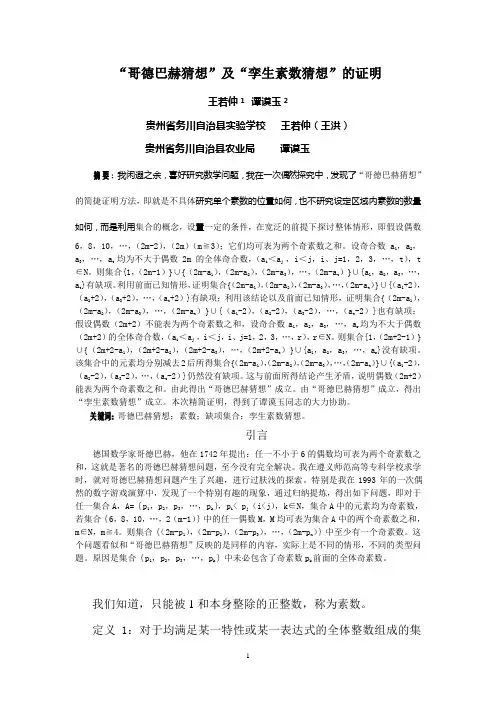
“哥德巴赫猜想”及“孪生素数猜想”的证明王若仲 1 谭谟玉2贵州省务川自治县实验学校王若仲(王洪)贵州省务川自治县农业局谭谟玉摘要:我闲遐之余,喜好研究数学问题,我在一次偶然探究中,发现了“哥德巴赫猜想”的简捷证明方法,即就是不具体研究单个素数的位置如何,也不研究设定区域内素数的数量如何,而是利用集合的概念,设置一定的条件,在宽泛的前提下探讨整体情形,即假设偶数6,8,10,…,(2m-2),(2m)(m≧3);它们均可表为两个奇素数之和。
设奇合数a1,a2,a 3,…,at均为不大于偶数2m的全体奇合数,(ai<aj,i<j,i、j=1,2,3,…,t),t∈N。
则集合{1,(2m-1)}∪{(2m-a1),(2m-a2),(2m-a3),…,(2m-at)}∪{a1,a2,a3,…,a t }有缺项。
利用前面已知情形,证明集合{(2m-a1),(2m-a2),(2m-a3),…,(2m-at)}∪{(a1+2),(a2+2),(a3+2),…,(at+2)}有缺项;利用该结论以及前面已知情形,证明集合{(2m-a1),(2m-a2),(2m-a3),…,(2m-at)}∪{(a1-2),(a2-2),(a3-2),…,(at-2)}也有缺项;假设偶数(2m+2)不能表为两个奇素数之和,设奇合数a1,a2,a3,…,ar均为不大于偶数(2m+2)的全体奇合数,(ai <aj,i<j,i、j=1,2,3,…,r),r∈N。
则集合{1,(2m+2-1)}∪{(2m+2-a1),(2m+2-a2),(2m+2-a3),…,(2m+2-at)}∪{a1,a2,a3,…,ar}没有缺项。
该集合中的元素均分别减去2后所得集合{(2m-a1),(2m-a2),(2m-a3),…,(2m-at)}∪{(a1-2),(a2-2),(a3-2),…,(at-2)}仍然没有缺项。
这与前面所得结论产生矛盾,说明偶数(2m+2)能表为两个奇素数之和。
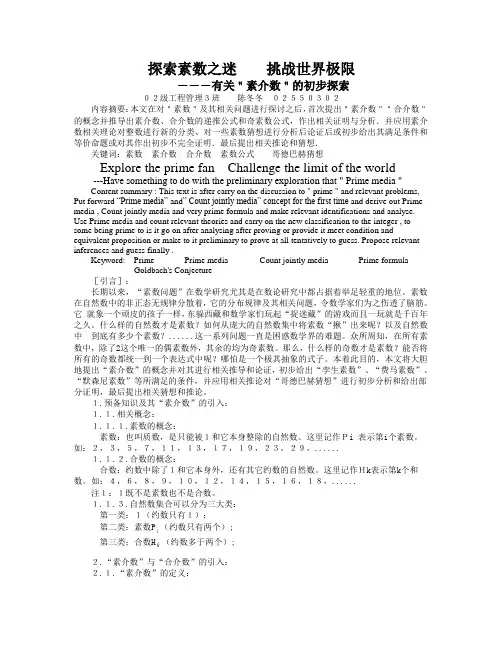
探索素数之迷挑战世界极限―――有关"素介数"的初步探索02级工程管理3班陈冬冬02550302内容摘要:本文在对"素数"及其相关问题进行探讨之后,首次提出"素介数""合介数"的概念并推导出素介数、合介数的递推公式和奇素数公式,作出相关证明与分析.并应用素介数相关理论对整数进行新的分类、对一些素数猜想进行分析后论证后或初步给出其满足条件和等价命题或对其作出初步不完全证明.最后提出相关推论和猜想.关键词:素数素介数合介数素数公式哥德巴赫猜想Explore the prime fan Challenge the limit of the world---Have something to do with the preliminary exploration that " Prime media "Content summary : This text is after carry on the discussion to " prime " and relevant problems, Put forward “Prime media” and”Count jointly media” concept for the first time and derive out Prime media , Count jointly media and very prime formula and make relevant identifications and analyse. Use Prime media and count relevant theories and carry on the new classification to the integer , to some being prime to is it go on after analysing after proving or provide it meet condition and equivalent proposition or make to it preliminary to prove at all tentatively to guess. Propose relevant inferences and guess finally .Keyword:Prime Prime media Count jointly media Prime formula Goldbach's Conjecture[引言]:长期以来,“素数问题”在数学研究尤其是在数论研究中都占据着举足轻重的地位。
关于孪生素数猜想的一个证明作者:张跃来源:《科技视界》2015年第28期【摘要】根据计算机的整数取值有限,本文提出了一个基本假设。
在此假设的基础上,利用C语言编程,证明了:对应于无穷多个素数p,存在无穷多个p+2的素数;即孪生素数猜想。
【关键词】孪生素数;假设;C语言程序【Abstract】In accord with the limitation of the integer taken by a computer, an assumption is suggested, and on the basis of it, using the program of C language, the paper proves that corresponding to infinite primes p, there are infinite p+2 being primes; namely, the conjecture of pair primes.【Key words】Pair primes; Assumption; Program of C language0 引言目前,数论中尚未解决的难题有两个,一个是偶数情形的哥德巴赫猜想,另一个是孪生素数的哥德巴赫猜想(孪生素数猜想)[1]。
从一些有关数学的期刊上可以发现,关于孪生素数的猜想,一直是国内外数学界关注和研究的一个重要课题。
迄今为止,数学家陈景润已经证明:存在无穷多个素数p,使p+2为不超过两个素数的乘积[2]。
国内外还没有人能够做到利用纯粹的数学理论方法证明这一猜想。
本文将设计C语言的程序证明孪生素数的猜想。
如果用Q (p)表示无穷多个素数p组成的集合,Q(p+2)是相应的无穷多个p+2的素数组成的集合,并且假设计算机二进制的数码的位数没有限制,则通过C程序的运算可以由Q(p)的所有元素得到Q(p+2)的所有元素。
从数学的观点看,可以将C程序的运算视为由Q(p)到Q(p+2)的一个映射M(mapping)[3],表示为M: Q(p)→Q(p+2)。
浅谈哥德巴赫猜想[推荐五篇]第一篇:浅谈哥德巴赫猜想浅谈哥德巴赫猜想(由来——筛法——哥猜热——个人见解)谈论哥德巴赫猜想,先从哥德巴赫本人说起。
哥德巴赫于1690年3月18日出生于普鲁士柯尼斯堡(现在的俄罗斯加里宁格勒)一个官员家庭,1764年11月20日卒于莫斯科,享年74岁。
曾在英国牛津大学学习;原学法学,由于在欧洲各国访问期间结识了贝努利家族,所以对数学研究产生了兴趣;曾担任中学教师。
1725年,到了俄国,同年被选为彼得堡科学院院士;1725年~1740年担任彼得堡科学院会议秘书;1742年,移居莫斯科,并在俄国外交部任职。
哥德巴赫除了在政治上积极进取这外,对科学技术也非常喜好,特别是对数学情有独钟。
作为数学家他是非职业的,纯属业余爱好,但他对数学却具有独到的洞察力,并与许多著名数学家交往甚密,又因为他的特殊的社会地位,使他的课题研究倍受重视,并激励了许多人参与研究。
由于他的课题独特,在当时很少有人涉及,一时很难解决,因此名声大振,吸引了大批人努力研究,从而推动了数学某一分支的发展。
哥德巴赫在数学分析领域上的研究成果是不高深的,但在数论方面,他的确的独到的见解,这一点在他于欧拉的通信中得到了证实。
欧拉是18世纪著名数学家之一,哥德巴赫比他年长17岁,从1729年开始到1963年的30余年中,他们之间的书信往来不断,成为了忘年交。
本文要谈的哥德巴赫猜想则是源于他们两人间的通信。
1742年6月7日,哥德巴赫给欧拉的信中提出了一个问题,即任何一个大于5的奇数是三个素数这和。
例7=3+2+2、9=3+3+3、15=3+5+7等等。
欧拉回信中说他相信这个猜想是正确的,但现在还不能证明它。
同时欧拉也提出了一个命题,即每个大于2的偶数都是两个素数之和。
例6=3+3、10=3+7、20=13+7等等。
这个命题也没能给出证明。
最终人们把这两个命题归结为哥德巴赫猜想。
即现在出现的,大致分为两个猜想:(1).每个不小于6的偶数都可以表示为两个奇素数之和;(二重哥德巴赫猜想)(2).每个不小于9的奇数都可以表示为三个奇素数之和。
哥德巴赫猜想吧素数间隔哥德巴赫猜想是数论中一项备受关注的问题。
它的核心观点是:任意一个大于2的偶数都可以表示为两个素数之和。
简言之,哥德巴赫猜想认为偶数可以分解为两个素数的和。
在这篇文章中,我们将以深度和广度的方式来探讨哥德巴赫猜想,从简单的定义到更深入的数学推导,帮助读者全面、深刻和灵活地理解这一问题。
一、哥德巴赫猜想的定义哥德巴赫猜想的提出者是17世纪的德国数学家哥德巴赫。
他认为,任意一个大于2的偶数都可以表示为两个素数之和。
6可以表示为3+3,8可以表示为3+5,以此类推。
哥德巴赫猜想被广泛研究,并引起了数学界的浓厚兴趣。
然而,尽管人们在过去几百年里进行了大量的探索和研究,至今仍未找到一个一般性的证明,使得哥德巴赫猜想成为一个定理。
二、素数的重要性在探讨哥德巴赫猜想之前,我们需要了解素数的概念和特性。
素数是只能被1和自身整除的正整数。
2、3、5、7都是素数。
素数的性质十分重要,因为它们在数论中有着特殊的地位。
素数的无穷性是数论中一项重要的定理,它指出素数的个数是无限的。
这也为哥德巴赫猜想提供了一个有趣的背景。
三、哥德巴赫猜想的证明尝试对于哥德巴赫猜想的证明尝试可以追溯到18世纪。
许多数学家都试图通过不同的方法来证明这个猜想。
其中一个著名的证明尝试是勒让德证明。
勒让德提出了一种思路,通过分析奇数和偶数之间的关系,说明可以将任意一个大于等于7的奇数分解为三个素数之和。
然而,尽管勒让德的证明在一定程度上具有启示性,但由于一些关键性的限制和缺陷,它并不能真正成为哥德巴赫猜想的证明。
四、素数间隔和相对素数在研究哥德巴赫猜想的过程中,我们可以探讨素数之间的间隔和相对素数的概念。
素数间隔是指相邻素数之间的差值,从2到3的间隔是1,从3到5的间隔是2。
在这之中,素数间隔的小于等于2的情况为相邻素数,例如3和5。
相对素数是指两个数之间没有共同的素因子,例如4和9就是相对素数。
通过研究素数间隔和相对素数,我们可以更深入地理解素数的分布和特性,为哥德巴赫猜想的研究提供一定的启示。
《哥德巴赫猜想》(共5则范文)第一篇:《哥德巴赫猜想》(共)[《哥德巴赫猜想》读后感]《哥德巴赫猜想》写作时,是人民文学主动邀请的,这是为1978年“全国科学大会”召开所做的一种思想和舆论准备。
可以说是时代所需,那时正是知识分子的转型期,从文化大革命对知识分子的摧残到逐渐的恢复。
《哥德巴赫猜想》写出了知识分子的心声,所以才会引起反响。
徐迟之前曾是以诗歌而引起关注的,之后转向报告文学。
但诗人的富于激情的语言结合科学的客观性,而成就了文学与科学的完美结合。
完美的艺术,知识分子对知识的渴求,国家对知识的重视。
大环境和小环境的需要,正是它成功的原因。
而90年代徐迟的报告文学,却反响平平。
不是因为他的艺术水平的欠缺。
而是当今的环境,在市场环境,消费主义,享乐观念的坏境下,金钱成了衡量一切的标准。
文学,科学,知识的边缘化。
人们价值观念的缺失。
这种种的社会环境所致的啊。
人类社会往往会从一个极端而走向另一个极端。
盲目的向前发展,而没看到事物的两面性。
由极端的追求精神需要到极端的物质追求,在追求精神建设的时候忽略了经济的发展,在发展经济的时候忽略了精神的建设,直至出现了许多问题的时候才有所警醒。
所以只好由缺失而警醒而改变。
这种被动的去改变,发展。
有时候是走走退退再退退走走的反复过程之中。
客观而理性的分析,让我受益匪浅。
也悟出了许多人生,社会的道理。
由于“哥德巴赫猜想”这一世界数学难题的被突破,人们知道了陈景润的名字,同时,也一样知道了王亚南的名字,知道了华罗庚的名字,知道了熊庆来的名字。
正如《人民日报》在转载徐迟同志的文章时所加的编者按里说的:“千里马常有,而伯乐不常有。
”发现人才,选拔人才,是不十分容易的。
我们很可以这样设想,没有王亚南这位“懂得人的价值的政治经济学批判家,突破哥德巴赫猜想的陈景润,很可能在50年代就为病魔缠倒,作为一个普通的中学教师默默无闻地死去!”王亚南为陈景润的进修和个性的发展,创造了方便的物质和生活条件,而华罗庚则从这位青年的数学论文中,发现了他身上的奇光异彩,立刻建议把他选调到科学院数学研究所来当实习研究员--正是在这里,陈景润在严师、名家的帮助熏陶下,得以充分发挥自己的才能,以飞速的步伐,跨上人类知识的顶峰,夺得具有世界水平的重大成就。
21岁大学生挑战哥德巴赫猜想的“姐妹猜想”图为张波与他发表在《科学决策》上的论文《孪生素数猜想》。
目前,他的证明方法正在国家知识产权局的审核环节中年仅21岁的大学生能用新方法证明孪生素数猜想?安徽理工大学化学工程学院大三学生张波挑战了这一难题。
国家级综合性理论月刊《科学决策》(9月刊)刊发了他的论文《孪生素数猜想》,虽然证明方法是否全新尚未盖棺定论,但张波深度探讨了猜想的证明方法,这一事实已经得到了专家的肯定。
目前,张波的孪生素数猜想新证明方法,正在国家知识产权局的审核环节中。
有哥德巴赫猜想的姐妹猜想之称的孪生素数猜想,自1849年由数学家波林那克提出之后,便引得无数数学家、数学爱好者为之着迷。
1966年,中国数学家陈景润在这方面得出了目前为止最好的结果。
根据2019年10月6日《科学决策》的专家、编辑对张波的评价,记者了解到,目前在全国能证明此猜想的人不超过5个人,张波的证明方法不同于以往的猜想证明。
虽然目前国家知识产权局等权威部门还没有最终确定张波的证明方法是否全新,但他运用了欧几里德原理证明猜想,方法新颖、简洁易懂。
宋以后,京师所设小学馆和武学堂中的教师称谓皆称之为“教谕”。
至元明清之县学一律循之不变。
明朝入选翰林院的进士之师称“教习”。
到清末,学堂兴起,各科教师仍沿用“教习”一称。
其实“教谕”在明清时还有学官一意,即主管县一级的教育生员。
而相应府和州掌管教育生员者则谓“教授”和“学正”。
“教授”“学正”和“教谕”的副手一律称“训导”。
于民间,特别是汉代以后,对于在“校”或“学”中传授经学者也称为“经师”。
在一些特定的讲学场合,比如书院、皇室,也称教师为“院长、西席、讲席”等。
一个大学本科还没有毕业的大学生是如何挑战这一世界数学难题的呢?10月5日下午,记者对张波进行了采访。
张波与孪生素数猜想的“相遇、相识”十分偶然,6月份的一天,张波到书店为自己带的家教学生买数学参考书。
在一本名为《高中数学知识清单》的书上,他第一次看见了孪生素数猜想。
一个种植界的哥德巴赫猜想【摘要】哥德巴赫猜想是一个种植界的著名猜想,历史悠久且引人关注。
该猜想描述了任何一个大于2的偶数可以分解成两个素数之和。
虽然一直未被证明,但许多数学家不断尝试证明这一猜想,相关研究也在进行中。
这一猜想的意义在于揭示了素数之间特定的关联,然而其困难之处也不可忽视。
未来,人们希望能够解决这一问题,因为它对数学领域至关重要。
哥德巴赫猜想的未来展望充满希望,其重要性也值得深思。
【关键词】关键词:哥德巴赫猜想、种植界、历史、描述、证明、研究、意义、困难、未来展望、重要性。
1. 引言1.1 什么是一个种植界的哥德巴赫猜想一个种植界的哥德巴赫猜想是数学领域的一个重要猜想,被认为是数论中的一颗明珠。
它涉及到素数序列之间的关系,而哥德巴赫猜想的形式是:任意一个大于2的偶数都可以表示为两个素数之和。
这个猜想由德国数学家哥德巴赫在18世纪提出,至今尚未被完全证明。
一个种植界的哥德巴赫猜想引起了数学界的广泛关注,许多数学家为了寻找证明这个猜想的方法而进行了大量研究。
这个猜想虽然简单明了,却蕴含着深刻的数学内涵,关乎素数分布规律和数论领域的重要性。
通过对一个种植界的哥德巴赫猜想的探讨,可以更深入地了解素数之间的关系以及数论中的一些重要概念。
这个猜想的研究不仅可以促进数学理论的发展,还有助于解决更多关于素数的问题,对整个数学领域都具有重要的启示意义。
1.2 哥德巴赫猜想的历史哥德巴赫猜想的历史可以追溯到1742年,德国数学家克里斯蒂安·哥德巴赫首次提出了这一猜想。
哥德巴赫猜想的内容是指任何一个大于2的偶数都可以表示为两个质数之和。
简单来说,就是每一个大于2的偶数都可以分解为两个素数之和。
这个猜想在当时并没有引起太大的关注,直到后来的数学家开始研究这个问题并且试图证明其正确性。
哥德巴赫猜想的证明一直困扰着数学界,至今仍未得到完整的证明。
虽然有一些部分相关的结果被证实,但整个猜想仍然是一个未解之谜。
论双生素数对 N生素数对及哥德巴赫猜想摘要:论文运用数列思想论述了双生素数对及n生素数对的无限性,运用数列和数轴对折思想论述了每个大于或等于6的偶数都可表示为两个奇素数之和,且随着偶数值的增大而表法数增多,既歌德巴赫猜想的正确。
关键词:素数对;数列;数轴对折中图分类号:g633.6 文献标识码:a 文章编号:1002-7661(2011)12-246-04我想先说一段话,茫茫之宇宙,它有没有边呢?若说有,则边那边又是什么呢?─还是宇宙─即宇宙之大给了我们一个无限大的概念,如果没宇宙会是什么呢?什么都没有,─但还会有一种状态的存在。
为什么会给人一种有的状态呢?宇宙的含量:空间、时间、物质。
自然数是无限的之如宇宙,其中素数是无限的,双生数对是无限的吗?n生素数对是无限的吗?无限的偶数都能表为两素数之和吗?诸如此类无限性问题,从人类发现至今,而困绕人们至今,难道这些无限性的问题超出了人类智能的极限,让人类的思维无能为力吗?本人多年来的思索得出结论:①双生素数对是无限的,设自然数为n,其内双生素数对个数为:tp(n)(tp表素数对),则tp(n)与n之比:n增大则其比值缩小,即:②n生素数对有无限之多哥德巴赫猜想表“1+1”成立,且随偶数值的增大而所表“1+1”的个数增多,设n为自然数,hp表“1+1”,hp(n)表n内hp之个数,则.................以下详细论述之:先引入几个新的概念:单元、双元、三元……n元数列:分别以1个数字,2个数字,3个数字……n个数字为1项的数列:如数轴上从3开始,连续3个奇数为一单元,则称为3元数列,如此,n 个连续奇数为一单元组成一项,称为n元数列。
连除:符号“”读作:“g,h”,如:{tn}表双元奇数数列,{tpn}表绝对剩余数列,符号“”表导出,p表素数,则:之存在先设一自然奇数数轴,如图(a)由3开始每3个连续自然奇数设为一组,称为:g,则其内的3个元素由小到大依次标为:ga、gb、gc,则所有的ga、gb、gc分别成单元等差数列:{gan}、{gbn}、{gcn}各公差分别为6,gan、gbn 、gcn分别为各数列通项。
所有的g构成数列:{gn}, gn为通项,g内有三个元素:ga、gb、gc其两邻项间ga、gb、gc各一一对应差值为6,则称{gn}为公差为6的三元数列。
现在问:{gan}、{gbn}、{gcn}之各数列是否能分别被一整数整除每一项?要想整除一单元数列每一列,则其首项与公差间必有共同因子(除1外)三单元数列公差分别为:6,即首项设为x,则各项设为6n+x(n ≥1为自然数)n为变量,x和6为不变量,要想整除单元数列之各项,则即为求6与首项x的共同因子(除1之外)三单元数列首项分别为:ga1=3、gb1=5、gc1=7,解得:ga1=3与公差6有共同因子3,所以{gan}数列之各项能被3所整除。
gb1=5和gc1=7与公差6无共同因子,所以没有任何整数能整除数列:{gbn}、{gcn}之每一项,由此素数便产生了。
数列{gn}之内所有ga元素能被3所整除,(即数列{gan}能被3所整除),所以数轴上没有连续的3个奇数全为3个素数之可能。
数列{gbn}、{gcn}各首项gb1=5、gc1=7与公差6无共同因子,所以除奇素数3外,所有奇素数都产生在数列{gbn}和{gcn}上。
因:{gbn}首项5与最小奇素数3之比为:3×1+2则:{gbn}之各项即为:3n+2(n为自然奇数)因:{gcn}首项7与最小奇素数3之比为:3×2+1则:{gcn}之各项即为:3n+1(n为自然偶数)则即为:3n+2= gbn 3n+1= gcn那么:gbn×gcn gbn× gbn gcn ×gcn=(3n+2)(3n+1) =(3n+2)(3n+2)=(3n+1)(3n+1)………………=gbn = gcn = gcn①②③由上三式便可推知所有素数是如何产生的。
在{gbn}、{gcn}数列上,第一个不能被最小奇素数3所整除的数便是素数,由此便产生{gbn}、{gcn}数列上的第一个素数,设为p1,再用p1去试除{gbn}、{gcn}数列之各项,第一个不能被整除的数便为素数:p2,把{gbn}、{gcn},被p1试除之后所剩数列各项,且不含被p1所确定的p2之值,即> p2且不包含被p1所整除各项称为:相对剩余数列,设为[{gbn}{gcn}] p1再用p2去试除相对剩余数列[{gbn}{gcn}] p1,则第一个不能被p2所所整除的数,即为素数p3,则相对剩余数列即为[{gbn}{gcn}] p2,即> p3且不包含被p1、 p2所整除各项,……如此进行下去,两个数列{gbn}、{gcn}同时被整除从而不断产生素数:p1, p2,p3 ……pn产生的素数p值越多,则数列{gbn}、{gcn}上的项被整除也就越多,无限进行下去,则p值为无穷之多,相对剩余数列:[{gbn}{gcn}] pn永远都存在。
设:n为自然数,其内p值个数记为:s(n)则:得结论:素数是如何产生的:除素数2和3外,所有素数都产生在数列{gbn}、{gcn}之上,因其各首项与其公差6无共同因子(除1外),其内由此产生素数p1, p2, p3 ……pn,至无穷。
素数是因数列{gbn}、{gcn}不能被任何数所同时整除各项而产生的。
论双生素数对的产生:先设一自然奇数数轴,如图(b)把每一个gn(g为无限)值之内的gb、gc两数点看作一个整体数点,(数轴上的每一个数字可看作每一个对应点),设为“t”,则所有“t”构成数列:{tn}(t为无限),并称为2元数列{tn},因其内含有两个单元数列{gbn}、{gcn},其各公差分别为6,则数列{tn}仍称为:公差为6的双元等差数列。
现在问,有什么数(当然是素数)能整除双元数列{tn}所有之各项?首先,数列{tn}是建立在单元数列{gbn}和{gcn}基础上的,而{gbn}、{gcn}已证无任何数能整除之各项,从而产生素数。
那么在数轴上,tn所含的两元素:gbn 、gcn即连续两个点,把其看作一个点,一个整体,而数列{tn}之公差为6,与首项之内两数:gb1=5、gc1=7都无共同因子,所以无任何素数能整除数列{tn}之每一项(此处整除:只要tn内两元素:gb、gc任何一个被整除,则称tn被整除,否则称不能被整除),由数列{gbn}、{gcn}上的第1个素数p1去试除{tn}之各项,则第一个不能被整除之tn记为t p1,把被p1试除后的数列,且不含t p1称为{tn}的相对剩余数列,记为[{tn}] p1,再用素数p2去试除[{tn}] p1之各项,第一个不能被整除tn记为t p2,则被p2试除后的数列仍称相对剩余数列,且不含t p2,记为:[{tn}] p2再用素数p3去试除[{tn}] p2之各项,则得t p3,其相对剩余数列记为:[{tn}] p3……如此类推,至pn仍会产生。
相对剩余数列[{tn}] pn,仍会产生t pn之值,至无穷(以上整除意义:只有其本身为唯一因子的不能称被整除)用符号“”表连除,“”表导出,{t pn}表被≤(n表自然奇数)素数连续整除后所产生的所有t p之值,称为绝对剩余数列,记为{t pn}则:({tn}为n之内所有t值所构成之数列)用n表自然数,w(n)表其内t p之个数则:结论:t p为无限之多,t p即为双生素数对。
即:双生数对有无限之多。
我建议职业数论专家,引进素数的产生是由于数轴上之数列{gbn}、{ gcn }之首项与公差6之间无共同因子从而不断产生素数这一思想(即:数列被连续试除这一思想)运用到其它众多数论问题中去,相信众多难题都会得到相应之解答,相信此思想可引导出众多的新的数论问题,从而又能得到相应之解答。
如三素数问题,则在数轴可以双生素数对为基础,而设定4元数列,如下图(c)如上图:x构成4元数列,公差为12,则型如:t p+p的三生素数对有无穷之多,y构成4元数列,公差为12,则型如:p+ t p的三生素数对有无穷之多z构成5元数列,公差为12,则型如:tp+tp的四生素数对有无穷之多。
如上图(c),数轴上能构成n元数列为无穷之多,其数列变化无穷,具体变化在此不再详述了!则n生素数对有无穷之多。
论哥德巴赫猜想1742年,哥德巴赫给欧拉的信中提到两个命题:a,任何一个大于或等于6的偶数都可表为两个奇素数之和,简称:“1+1”,即:一个素数加一个素数。
b,任何一个大于或等于9的奇数都可表为三个奇素数之和,显然命题b是命题a的推论,只要证明了命题a,则命题b不功自破。
几百年来,数学家们的研究至1920年,布朗用筛法证明了“9+9”,至1966年陈景润证明了“1+2”,至今再无进展。
本人11岁知晓此题,思索至今,想仍然由数列之整除性来论叙此命题,从而得结论:任何大于或等于6的偶数都可表为两个奇素数之和,即“1+1”,且随着偶数值的增大而表法数增多。
如前论述,由数列{tn}则可导出双生素数对之存在,之无限性。
那么我们想表达的偶数等于两素数之和在数轴上表示会是一种什么概念呢?我想说它是一种把自然奇数数轴上的数列{gbn}和{ gcn }对折过来同时又形成了另一种数列的概念。
所有素数除2和3外都产生在数列{gbn}和{ gcn }上,下图为数列{gbn}、{ gcn }在数轴上的对折性质。
最小对折点取5,如图,共有6种对折结果,对折点记为ho,即ho≥5为自然数。
以上各图,把对折点至数轴始端称为前项,则另一端称为后项,虚线…...所示前后项中一一对应的两奇数和值为各对折点ho的值的2倍。
由图知,在前后对折项中,任何一个gn之内,至少有一组相对应的:g b与gb,gc 与gc,gb 与gc相结合,或gb,gc之2倍,至多有两组: gb 与gc的组合,其和值皆为各对折点值的2倍。
(以上g、ga 、gb 、gc之意义同前图(a))gbn、gcn点是产生素数之点(前已论述,所有素数除2和3外,都产生在数列{gbn}、{gcn}之上),现在问,在同一对折点的对折数轴中所构成的一一对应的gbn与 gbn, gcn与 gcn,gbn与 gcn之各两点数值是否同时为素数呢?如下图所示: gn 数轴图和hn数轴图(对折点ho=46实例图)上图:gn数轴对折实例图中,虚线“:”,表前后项(以对折点至数轴始端为前项,另一端则为后项)中gcn与gcn之值一一对应,各两两之和皆为对折点之值ho=46的2倍。
前后项中一一对应之两点gcn与gcn,是可能产生两个数都为素数之点,把此类两点分别看作一个点,并称之为:对折理想素数对点,记作“h”,则所有之h点又构成了一列数列{hn},见上图:hn 数轴图,其公差为6(因前后项一一各值公差为6,即{gcn}之公差为6,所以{hn}公差为6),称{hn}为对折双元数列。